|
|
GIZE, STONEHENGE, CHICHEN ITZA, ETC,ETC: COPACABANA (BOLIVIA) - LA PUERTA DEL SOL (NEXO BIBLICO)
Scegli un’altra bacheca |
|
Rispondi |
Messaggio 1 di 76 di questo argomento |
|
MATEO
24:29 E inmediatamente después de la tribulación de aquellos días, el sol se oscurecerá, y la luna no dará su resplandor, y las estrellas caerán del cielo, y las potencias de los cielos serán conmovidas.
24:30 Entonces aparecerá la señal del Hijo del Hombre en el cielo; y entonces lamentarán todas las tribus de la tierra, y verán al Hijo del Hombre viniendo sobre las nubes del cielo, con poder y gran gloria. (LA SEÑAL ES ORION. El 21 de junio el sol esta practicamente en conjuncion con ORION)
24:31 Y enviará sus ángeles con gran voz de trompeta, y juntarán a sus escogidos, de los cuatro vientos, desde un extremo del cielo hasta el otro.
24:32 De la higuera aprended la parábola: Cuando ya su rama está tierna, y brotan las hojas, sabéis que el verano está cerca. (En el hemisferio sur el 21 de junio comienza el invierno pero en el hemisferio norte comienza el verano. EN EL SOLSTICIO ES EL DIA MAS LARGO DEL AÑO. PLENITUD SOLAR)
24:33 Así también vosotros, cuando veáis todas estas cosas, conoced que está cerca, a las puertas.
El año nuevo Aymara comienza el 21 de junio, con el solsticio de invierno y con el inicio de un nuevo ciclo agrícola (nueva época de siembra). Este es el momento elegido para la celebración del Año Nuevo Andino, los amautas “Sacerdotes andinos” han encontrado el punto clave para que retorne el reordenamiento de la tierra.
Esta fiesta está perfectamente integrada en nuestra cultura, y nada ha podido desenraizarla de nuestros corazones. Los antiguos indígenas agricultores del altiplano andino, se regían por la observación de diversos fenómenos astronómicos para guiarse en los momentos que debían iniciar las diversas faenas agrícolas y ganaderas, como siembras, cosechas y esquilas a los camélidos andinos.
 Es el momento del comienzo de un año nuevo, con la voz de nuestros ancestros, en el canto eterno unido al corazón de la Madre Tierra y a la del Universo “Pachamama y Pachakama” Es el momento del comienzo de un año nuevo, con la voz de nuestros ancestros, en el canto eterno unido al corazón de la Madre Tierra y a la del Universo “Pachamama y Pachakama”
Con el brillo de los primeros rayos de Sol y la esperanza de unidad del universo que nos inspira a unificar nuestros corazones en la alegría de la vida y a entender el viaje sagrado.
 En este nuevo tiempo es importante que asumamos la responsabilidad generacional de ser seres y puentes que formen parte activa del reordenamiento de la vida en este proceso de Pachakuti. En este nuevo tiempo es importante que asumamos la responsabilidad generacional de ser seres y puentes que formen parte activa del reordenamiento de la vida en este proceso de Pachakuti.
TIWANAKU
Esta fue una antigua ciudad sagrada indígena de Sudamérica y la más importante. Aunque se conoce poco de su historia, se cree que fue la cuna de un imperio que se extendió por el altiplano. Cada 21 de Junio se realizan en el lugar coloridas ceremonias indígenas que recuerdan un pasado lleno de esplendor.
 "Este día los primeros rayos de Sol penetran por la puerta del templo de Kalasasaya e iluminan al magnífico Monolito “Ponce". Los andinos de Bolivia, Chile y Perú, celebran este día el inicio del año nuevo andino, en medio de ritos y ofrendas al Inti (Sol) y a La Pachamama (Madre Tierra) quienes invocan también la fertilidad de la tierra con el sacrificio de llamas, cuya sangre es una ofrenda al Sol y la Tierra y a otras deidades andinas para asegurar la prosperidad agrícola y pecuaria. "Este día los primeros rayos de Sol penetran por la puerta del templo de Kalasasaya e iluminan al magnífico Monolito “Ponce". Los andinos de Bolivia, Chile y Perú, celebran este día el inicio del año nuevo andino, en medio de ritos y ofrendas al Inti (Sol) y a La Pachamama (Madre Tierra) quienes invocan también la fertilidad de la tierra con el sacrificio de llamas, cuya sangre es una ofrenda al Sol y la Tierra y a otras deidades andinas para asegurar la prosperidad agrícola y pecuaria.
El sentido del rito es asegurar la reproducción de la vida con las bendiciones del Sol para la siembra y la cosecha y este rito rememora antiguas prácticas de las comunidades aymaras.
TOUR AL SOLSTICIO DE INVIERNO EN TIWANAKU
CADA 21 DE JUNIO
03:30 am. Empezamos a recoger a los turistas de sus hoteles/hostales de la ciudad de La Paz, para dirigirnos a través de una carretera asfaltada a Tiawanaku, ubicado a una hora y media en transporte de la ciudad del La Paz, arribo e ingreso a “Kalasasaya” y allí recibiremos los primeros rayos del Sol y participaremos de la ceremonia principal ofrendada al Inti, luego de recibir el año nuevo andino visitaremos el centro arqueológico de Tiawanaku y la Feria típica que se realiza ese día en la Plaza principal de la Población de Tiwanaku.
 
Incluye: Transporte turístico compartido, desayuno, ingreso, guía.

EL 21 DE JUNIO (SOLSTICIO DE VERANO EN EL HEMISFERIO NORTE) Y SU NEXO CON LA PUERTA (SANTO GRIAL) DEL SOL (NUEVO ISRAEL SEGUN EL SUEÑO DE JOSE EN GENESIS 37) (PENTECOSTES)
El verdadero PENTECOSTES es en el SOLSTICIO DE VERANO y tiene fuerte nexo CON EL SOL Y LA PUERTA. Increiblemente en los pueblos originarios latinoamericanos tambien tenemos un PATRON DE ORIGEN CRISTIANO.
21 DE JUNIO DE CADA AÑO - SOLSTICIO DE INVIERNO
“AÑO NUEVO AYMARA” TIWANAKU - BOLIVIA

|
|
|
|
Rispondi |
Messaggio 2 di 76 di questo argomento |
|
| OBSERVATORIOS ANDINOS |
| |
| • |
Los pueblos andinos construyeron en todo su territorio una serie de observatorios astronómicos, desde donde realizaban observaciones del Sol, la Luna, los planetas y las constelaciones.
|
| • |
Estas observaciones estaban destinadas a ser indicadores para sus dos grandes calendarios, el agrícola y el ceremonial.
|
| • |
Los observatorios más conocidos eran los solares, fueron construcciones orientadas a los puntos cardinales y con ciertas marcas hacia los solsticios y los equinoccios.
|
| • |
Existían otros lugares dedicados a las observaciones de ciertas constelaciones, por lo general se las realizaba desde lugares muy altos como las apachetas, estas observaciones se realizaban antes del amanecer. |
|
|
OBSERVATORIO DE TIWANAKU
|
|
...:: TIWANAKU ::...
 |
|
Vista aérea del centro ceremonial de Tiwanaku
|
|
...:: UNA PROPUESTA DE TIWANAKU ::...
 |
|
Reconstrucción ideal del centro ceremonial, propuesto por el Arq. Javier Escalante, actual director de la Unidad Nacional de Arqueología de Bolivia
|
|
...:: Observación de Equinoccios y Solsticios desde el KALASASAYA ::...
 |
|
La construcción denominada Kalasasaya, es un observatorio Solar, ya que desde su interior se verifican los solsticios y los equinoccios, según el diagrama de la derecha y la fotografía de la izquierda es el equinoccio de otoño, ingresando por la puerta principal de aquel templo.
|
|
...:: EL CALENDARIO ANDINO EN LA PUERTA DEL SOL ::...
 |
|
La puerta del Sol y la posición del friso que indicaría, según el investigador A. Posnaski el calendario solar de la cultura Tiwanaku.
|
|
...:: El calendario Solar según A. Posnaski en la Puerta del Sol ::...
 |
|
Detalle del friso de la puerta del Sol, con el detalle de la iconografía que representaría a los 12 meses del año, según un ciclo de izquierda a derecha, por la parte superior, que se inicia el 21 de junio y su retorno de derecha a izquierda por la parte inferior.
|
|
...:: EL TEMPLETE SEMISUBTERRANEO ::...
 |
|
El templete denominado semisubterraneo, es un centro ceremonial relacionado con la Pachamama y el Mankapacha (lo de abajo y los difuntos), desde su interior se realizan observaciones nocturnas tanto de posiciones de estrellas como de las lunaciones.
|
|
...:: Observaciones astronómicas desde el interior del Templete semisubterraneo ::...
 |
|
Vista desde la pared norte en el interior del templete semisubterraneo, se aprecia la escalinata de ingreso que esta hacia el sur y al frente la pirámide de Akapana aun no restaurada, el 3 de Mayo la constelación de la Chalana (cruz del sur) se coloca en forma vertical al centro de la escalinata, siendo un indicador astronómico del fin del ciclo agrícola y la época de la cosecha.
|
|
...:: LA PIRAMIDE DE AKAPANA ::...
 |
|
Una de las construcciones mas importantes de Tiwanaku es la pirámide de Akapana, la que aun no ha sido completamente descubierta ni restaurada, es un centro ceremonial, destinado al Alajpacha, (lo de arriba) y desde donde se realizaban observaciones astronómicas de las constelaciones andina, como indicadores de eventos ceremoniales o agrícolas.
|
|
OBSERVATORIO ANDINO, COPACABANA
|
|
...:: COPACABANA ::...
 |
|
Otra construcción dedicada a las observaciones de los solsticios y equinoccios es la llamada Horca del Inca, situada en cercanías de la población de Copacabana en el lago Titicaca, en la fotografía se encuentra en el cerro de la izquierda, donde esta saliendo una columna de humo.
|
|
...:: OBSERVACIÓN DEL SOLSTICIO DE INVIERNO DESDE LA HORCA DEL INCA ::...
 |
|
La denominada Horca del Inca, no es horca ni inca, es una de los observatorios astronómicos mas antiguos de América, donde se observaban los solsticios y los equinoccios, en la fotografía superior se observa el ingreso de un has de luz por un orificio en el momento del solsticio de invierno, nótese la forma de la roca, la que cubría en penumbras a la denominada horca del inca y solo dejaba pasar un rayo de luz que se posa en el dintel superior de esa construcción (foto inferior), marcando el inicio del año nuevo andino (21 de junio).
|
|
|
|
|
|
|
|
Rispondi |
Messaggio 3 di 76 di questo argomento |
|
Popoli Indigeni
|
 Bolivia: Pueblos originarios recibieron el año 5.512 en sus lugares sagrados Bolivia: Pueblos originarios recibieron el año 5.512 en sus lugares sagrados
Agencia de Prensa Alteña
Puerta del Sol Tiwanaku foto: www.comunidadboliviana.com.ar
Los primeros rayos del sol del solsticio de invierno están impregnados de energía renovadora para los descendientes de los pueblos originarios.
Danzas milenarias que aún se conservan y que darán la bienvenida al Machaq Mara se apoderará de las frías avenidas de El Alto. Amautas afirman que las energías del astro sol, exigen a sus hijos a luchar contra la corrupción y de la defensa de los recursos naturales que guarda la sagrada Pachamama. Las ruinas de Tiwanaku, Qonqho, Copacabana y El Alto centros de los ritos del Año Nuevo Aymara.
Las wak'as presiden las ofrendas al tata willka que otorga energía a sus hijos que lo veneran en pleno Siglo XXI.
Inundando el aire que respiran los seres vivos de olores agradables a hierbas aromáticas (k’oa, copal e incienso), levantado las palmas dirigidas a los primeros rayos del sol, los pueblos originarios recibirán al Machaq Mara (año nuevo), Mara Taq’a, Willka Kuti y Pachakuti en las elevadas apachetas y al pie de las sagradas Wak’a (lugares elegidos por los dioses tutelares).
Las ruinas de Tiwanaku, Qonqo (cerca de Jesús de Machaca), la ahorca del Inca en Copacabana y El Alto, se convierten en centros de los ritos ejecutados para dar la bienvenida al Machaq Mara (Año Nuevo) de los pueblos originarios, que vuelven a tomar fuerza en pleno Siglo XXI, después de mantenerse en la clandestinidad durante varios siglos.
Ahí aguantando el crudo frío invernal con coloridos ponchos de lana de llama, oveja y de alpaca, a pocos metros de las hogueras donde quemaron las ofrendas, los descendientes de los pueblos originarios, dirigen sus palmas hacia los rayos del Tata Willka (padre sol), los cuales en el solsticio de invierno están impregnadas de energía positiva, a criterio de los amautas que ejecutan los tradicionales ritos en homenaje al Sol.
Una exclamación y oraciones milenarias que brotan de las amautas, forman parte del escenario del recibimiento del Machaq Mara, tanto en las ruinas precolombinas como en las apachetas y las wak’as, lugares donde se desarrollan los ritos ancestrales.
La ejecución del rito de bienvenida al Macha Mara que se inicia con los primeros rayos solares del 21 de junio, los preparativos se inician día antes con el tradicional acullicu (masticado de coca), donde se hace una vigilia hasta el día siguiente.
Wilancha y ofrendas
En el caso de las organizaciones sindicales o originarias, para que los dioses tutelares que moran los nevados de Los Andes y la Pachamama (madre tierra) sean magnánimos con las siembra y los objetivos que persiguen las entidades, se procede a la tradicional willancha (ch’alla con sangre de llama sacrificada) a la Pachamama (madre tierra).
Antes de que aparezcan los primeros rayos del sol, en las ruinas de Tiwanaku, Qonqo y la Ahorca del Inca en Copacabana, se otorgan las wat’as (ofrendas) a los achachilas (nevados) y se pide permiso a ellos para ejecutar el rito del recibimiento del Machaq Mara. En la inmensa hoguera que se arma, las comunidades a través de sus autoridades entregan al amauta que preside la ceremonia las ofrendas, consistentes en dulces, lanas de color, sullus (fetos de llama) y hierbas aromáticas.
Fuerzas para luchar contra los neoliberales
Rufino Paxi, amauta pionero de las organizaciones de las ceremonias del recibimiento del Machaq Mara en las ruinas milenarias de Tiwanaku, manifestó que este año los pueblos originarios deben centrar su pedido con todo corazón y cabeza fuerzas para luchar contra los neoliberales, quienes a través de sus partidos, sus diputados y peones, dividen a las organizaciones sindicales e impulsan el saqueo de los recursos naturales que guarda en sus entrañas la Pachamama. "Los pueblos originarios, de una vez tenemos que acabar con los lobos que nos sumen en la pobreza", manifestó.
Entrada autóctona
Más de 31 comunidades aseguraron su participación en la tradicional entrada de Conjuntos Autóctonos que se desarrolla todos los años en la ciudad de El Alto como parte del Año Nuevo Aymara (Machaq Mara) que se celebra el 21 de junio, según el informe de Idelfonso Suxo, presidente del Comité Cívico Interprovincial de La Paz, entidad que organiza la demostración anual con el apoyo de la Sociedad Boliviana de Cemento (Soboce) y la comuna alteña.
La entrada de danzas autóctonas que son interpretadas por las comunidades de las provincias paceñas, comenzará en la Av. Sucre (inmediaciones del Complejo Fabril), tras recorrer la Av. Juan Pablo II y pasar el puente del actual Distribuidor de la Ceja, concluirá en la Av. Antofagasta de Villa Dolores.
Mocolulos, la danza de los kusillos, quena quenas, pinquilladas, jula julas, wakatintis, ch’unchus, moseñadas y otras danzas que se bailan en ocasiones especiales en los pueblos originarios, serán interpretadas por los propios comuneros. El año pasado, la demostración que se inició a las nueve de la mañana concluyó a las cuatro de la tarde.
Suxo informo que la demostración se desarrolla en la urbe alteña, debido a que está identificada como la nueva capital de los pueblos originarios del Siglo XXI.
www.adital.org.br
|
|
|
|
|
Rispondi |
Messaggio 4 di 76 di questo argomento |
|
Tiahuanaco es el sitio arqueológico más importante de Bolivia. Junto al pueblo que lleva el mismo nombre, se encuentran las ruinas arqueológicas de la cultura preincaica conocida como Tiahuanaco o Tiawanaku.
|
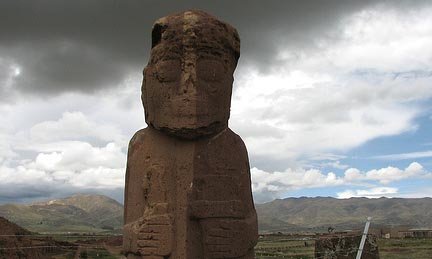
Las ruinas de Tiahuanaco están ubicadas a 3.885 msnma. a 70 km de la ciudad de La Paz, por carretera, y a unos 15 km. del Lago Titicaca.
|
|
|
¿Cómo llegar a Tiahuanaco?
Desde La Paz hay buses que parten cada media hora desde la calle José María Asín (en la zona del cementerio de La Paz). La duración del viajes es de 1,30 hs. También hay varias agencias de viajes que organizan tours diarios.
|
|
Tiahuanaco es un lugar que se puede visitar en un día, aunque si alguien prefiere quedarse a dormir en la zona para continuar con la visita al día siguiente lo puede hacer en alguno de los hostels y alojamientos que hay en el pequeño pueblo muy cercas de las ruinas.
El horario para visitar las ruinas es de 9.00 ha 17.00 hs.
La cultura Tiahuanaco es una de las que más duró en América del Sur desde el año 1500 A.C. al 1200 D.C. (27 siglos) y sus dominios físicos se extendieron a 600.000 Km2. Los tiahuanacos alcanzaron un importante desarrollo en las ciencias, técnicas, agricultura y arquitectura.
|
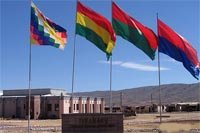 Ruinas de Tiahuanaco |
|
Se ha encontrado influencia de la cultura tiahuanaco en Ecuador, Perú, Argentina y Chile.
La Puerta del Sol
Este monumento de Tiwanaku es conocido a nivel mundial como la mayor muestra del grado de perfección que alvanzó la cultura, tanto por el arte, como por la simbología que atesoran sus bajos relieves.
|
|
|
Este hermoso portal lítico -trabajado en un solo bloque de piedra andesita de aproximadamente 10 Tn. de peso- no fue, en el pasado, una pieza aislada sino, mas bien, parte de una edificación mayor que pudo ubicarse en la cima de la Pirámide de Akapana o en el mismo kalasasaya, donde existen varias piezas del mismo material de esta puerta.
Pirámide de Akapana
La "Akapana" era una pirámide de 800 m. de perímetro y 18 m. de altura formada por , 7 terrazas escalonadas. En la parte superior había edificaciones destinadas a los cultos religiosos y a la astrología. Para la construcción se utilizaron diferentes técnicas por lo cual se presume que fue mucho el tiempo que se demoró en levantarse.
|
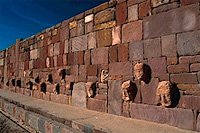 Ruinas de Tiawanaku |
|
Kalasasaya
Kalasasaya (kala = piedra; saya o sayasta = parado) o Templo de las Piedraa Paradas, tiene un diseño exacto vinculado con la astrología, desde este sitio se verificaban con la duración del año solar y el cambio de cada estación. En ambos equinoccios (otoño: 21 de marzo y primavera: 21 de septiembre) el Sol nacía por el centro de la puerta principal de ingreso. En el solsticio de invierno (21 de junio) el Sol nacía en el ángulo murario N.E. el solsticio de verano (21 de diciembre) se marcaba por el nacimiento del Sol en el ángulo murario S.E. Esta exactitud es un ejemplo del avance científico y técnico de la cultura Tiahuanaco.
El Monolito de Ponce
Lleva el nombre del arqueólogo boliviano (Carlos Ponce) que lo descubrió en el año 1957.
Es una de las figuras mejor logradas y conservadas de todo Tiahuanaco. La figura humana en sus manos sostiene un kero (vaso sagradao) y además se destaca las figuras de animales como el pumas, cóndores y águilas.
Puerta del Sol
La Puerta del Sol es la obra más significativa de Tiahuanaco. En su friso se observa la imagen del Dios Sol que sostiene en cada mano un cetro con figuras de aves. A manera de rayos se desprenden de su testa figuras zoomorfas entre las que se advierten cabezas intercaladas de felinos; varias de las figuras concluyen en discos solares, insinuando que el Sol es vida y Dios capaz de sostenerla. Sobre el rostro se dibuja la silueta de un puma. Pendiente de los brazos lleva dos cabezas trofeo. El Dios Sol, se ve rodeado por 32 figuras de Hombres-Sol, y 16 figuras de Hombres-Águila.
|
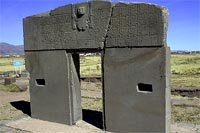 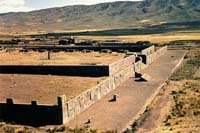 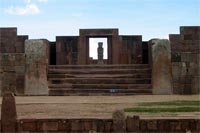 |
|
|
|
|
Rispondi |
Messaggio 5 di 76 di questo argomento |
|
|
|
|
Rispondi |
Messaggio 6 di 76 di questo argomento |
|
21 DE JUNIO DE CADA AÑO - SOLSTICIO DE INVIERNO - AÑO NUEVO ANDINO. ... Tour a Copacabana - Isla del Sol · Tour a la Isla del Sol y de La Luna ... "Este día los primeros rayos de Sol penetran por la puerta del templo de Kalasasaya ...
www.turismoboliviaperu.com/pagesp/.../solsticio_de_invierno.php - En caché - Similares
22 Jun 2007 ... Solsticio de Invierno en el Lago Titicaca: Read the story and see 14 photos of a visit to Copacabana-Isla del Sol, Bolivia by TravelPod member ...
Observación de Equinoccios y Solsticios desde el KALASASAYA ::. ... La puerta del Sol y la posición del friso que indicaría, según el investigador A. ... Horca del Inca, situada en cercanías de la población de Copacabana en el lago Titicaca, ...
Tour al Solsticio de Invierno - Año Nuevo Ayamara · Tour a Copacabana ... "Ese día los rayos del Sol al amanecer penetran por la puerta del templo Kalasasaya ...
Puerta del Sol Tiwanaku foto: www.comunidadboliviana.com.ar. Los primeros rayos del sol del solsticio de invierno están impregnados de energía renovadora ...
En ambos equinoccios (otoño: 21 de marzo y primavera: 21 de septiembre) el Sol nacía por el centro de la puerta principal de ingreso. En el solsticio de ...
Solsticio de invierno y año nuevo, Aymará 21 de junio. ... Es interesante visitar el Santuario de la Basílica de la virgen de Copacabana (1.588) monumento ... Es interesante visitar la Puerta del Sol, la Puerta de la Luna, el Templete semi ...
www.caminorealaparthotel-spa.com/es/.../lugares-para-visitar.html - En caché - Similares
3 Nov 2011 ... Hoteles Copacabana, Historia de Copacabana, Clima de ... Esta puerta extraña trilítica encaramado en la colina está rodeada de rocas perforadas ... rayos del sol pasen a través del dintel durante el solsticio del 21 de junio, ...
Es una tradicion boliviana andina, un festival para celebrar el solsticio de ... a que los rayos del sol pasen por la Puerta del Sol, ubicada en el mismo Templete, que ... En La Paz habrá celebraciones en Tiwanaku, Sorata, El Alto, Copacabana, ...
Copacabana; este autor asimismo dio la siguiente lista de grupos de todo el imperio: ... puerta de acceso hacia el peregrinaje que los incas realizaban hacia las .... rocas puestas de tal manera que cuando el sol se encuentra en el solsticio ...
iberoamericaglobal.huji.ac.il/.../Microsoft%20Word%20-%2009-Rivera.pdf - En caché - Similares
Anuncios
-
Room in Rio de Janeiro ? We have cheap rooms. Book now!
www.yeego.com/Copacabana_Sol_Hotel
|
|
|
|
Rispondi |
Messaggio 7 di 76 di questo argomento |
|
Los Aymaras "Hay indicios de que la cultura aymara es anterior a la egipcia y la sumeria" En los templos de la ciudad se han encontrado dibujos de animales del pleistoceno , extinguidos hacia el año 12000 A.C. Las aguas del lago albergan especies de la fauna marina, cuya presencia a 4.000 mts de latitud solo podría explicarse como consecuencia de una marejada planetaria.  Los Moais de la isla de Páscua miraban a Las Pleyades y a Orión. el astrónomo William Liller descubrió que, aunque algunas de estas estatuas de piedra estaban situadas en paralelo a la costa, sus ahus o plataformas ceremoniales no lo estaban y que otras ubicadas más al interior tampoco seguían esta norma. Y dedujo que su posición podía corresponderse con una orientación astronómica, que en un primer momento relacionó con los equinoccios y solsticios y con disposiciones solares. Nos dimos cuenta de que muchas de las orientaciones interpretadas por Liller como equinocciales en realidad se correspondían con el cinturón de Orión (Tautoru), y que la gran mayoría de las solsticiales se relacionaban con la ubicación de las Pléyades (Matariki), el asterismo más importante de la cultura Rapa Nui.   Como podrás observar las civilizaciones antiguas "misteriosamente" sabían mas de las estrellas, orbitas, alineaciones planetarias, constelaciones y equinoccios de lo que el hombre civilizado pudo saber. Aun sabiendo todo esto, el occidentalismo se impuso y la ciencia hizo creer "civilizadamente" durante mucho tiempo que la tierra era plana y que eramos el centro del universo. 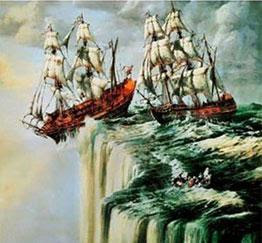 Como siempre amigo, un placer..  Para mas información sobre Lugares "Sagrados" dejo el link del foro donde posteaba antes y en el que deje un resumen de la geografía mágica de la tierra: autopoiesis.crearforo.com/lugares-sagrados-geografia-magica-de-la-tierra-es1662.html |
|
|
|
Rispondi |
Messaggio 8 di 76 di questo argomento |
|
LA PIRAMIDE DETRAS DE LA PUERTA EN EL CODIGO DA VINCI
CODIFICADO EL SANTO GRIAL
FIJENSE AL MINUTO CON 4 SEGUNDOS
|
|
|
|
Rispondi |
Messaggio 9 di 76 di questo argomento |
|
|
|
|
Rispondi |
Messaggio 10 di 76 di questo argomento |
|
Pyramids of Akapana, Bolivia
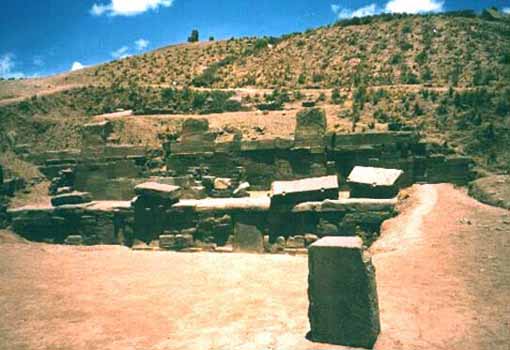
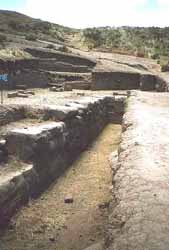
Drainage
The 59-foot-tall Akapana resembles a large natural hill more than a pyramid. Closer inspection shows walls and columns sticking out from the base and carved stones on its summit and tumbling down the sides. The somewhat amorphous shape of this tremendous pyramid is the result of centuries of looting and quarrying of its stones for colonial churches and even for a railway built in the 1900s. New research shows that this pyramid was never quite finished in antiquity.
At Tiwanaku we seem to have an interesting situation where the city's previous infrastructure was razed and completely redone just before the city was suddenly abandoned. It seems that around A.D. 700, three centuries into the existence of Tiwanaku as a monumental and powerful city, there was a sudden change to direct all construction efforts toward building what was the largest structure in the Andes. The previous monuments of the city were torn down and their stones reused to build the Akapana pyramid. The effort was too great, and the pyramid lay unfinished when the city was abandoned. One Spanish chronicler said of Tiwanaku, "They build their monuments as if their intent was never to finished them."
Around the rising pyramid, the arrangement of small single homes was replaced by large square compounds--also using the scavenged remains of previous monuments--serving perhaps as ritual places for powerful families or ethnic groups. What this change represents is unknown at the present. This could represent the rise of a powerful king, a popular religious movement, or the formation of a multicultural city. Whatever the cause behind this massive transformation, it didn't last long. By A.D. 950 all monumental construction suddenly ends with stones in various stages of dressing scattered around the partially built monuments.
The Akapana Pyramid Mound
In the News ...
Bolivian pyramid makeover disappoints MSNBC - October 19, 2009
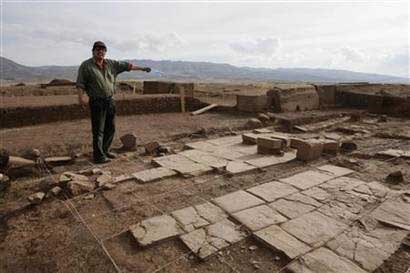
Tiwanaku, Bolivia - Eager to attract more tourists, the town of Tiwanaku in the Bolivian Andes has spruced-up the ancient Akapana pyramid with adobe instead of stone, in what some experts are calling a renovation fiasco. Now, the Akapana pyramid risks losing its designation as a U.N. World Heritage Site, and there is concern the makeover could even cause its collapse. P> The pyramid is one of the biggest pre-Columbian constructions in South America and a building of great spiritual significance for the Tiwanaku civilization, which spread throughout southwestern Bolivia and parts of neighboring Peru, Argentina and Chile from around 1500 B.C. to A.D. 1200.
Jose Luis Paz, who was appointed in June to assess damage at the site, says the state National Archeology Union, UNAR, erred in choosing to rebuild the pyramid using adobe, when it is clear to the naked eye that the original was built of stone. "They decided to go free-hand with the (new) design ... There are no studies showing that the walls really looked like this," Paz told Reuters as he stood before the pyramid in the Tiwanaku archeological site, some 40 miles north of Bolivia's administrative capital of La Paz. According to Paz, who now heads excavation at the site, the town of Tiwanaku hired the UNAR to renovate Akapana to make it "more attractive for tourists," regardless of how the pyramid may have originally looked like.
Thousands of tourists visit Tiwanaku every year and pay about $10 to enter the site, but the village of Tiwanaku, which manages the park, thought a better-looking pyramid would attract even more visitors, he said. Culture Minister Pablo Groux dismissed some of the criticism and said the renovation was long called for. "The UNAR has restored the original form the pyramid had. If we look at pictures from five years ago, there was just a hill there. What we can see now is something close to what the construction originally looked like," he told Reuters. Still, Paz said the controversy is not only about aesthetics.
The archeologist said lower decks are slightly tilted because of the extra weight of the adobe walls, which could lead to the collapse of the pyramid. The United Nations Educational, Scientific and Cultural Organization, or UNESCO, is due to visit Tiwanaku shortly and if it decides Akapana has been excessively tampered with, it may drop Tiwanaku from its list of World Heritage Sites. In 2000, UNESCO decided that Tiwanaku deserved to be in the list because its ruins "bear striking witness to the power of the empire that played a leading role in the development of the Andean pre-Hispanic civilization."
The Tiwanaku civilization, which flourished around Lake Titicaca, was one of the precursors of the Inca empire, the largest pre-Columbian civilization in the Americas. Groux believes that Tiwanaku will not lose its World Heritage status because the government halted the reconstruction project earlier this year, as soon as UNESCO told them to. "The inclusion in the list of World Heritage Sites involves regular checks, because some places may lose the essence of why they were included in the list. In the case of Tiwanaku losing that title is unlikely," he said.
Looting of Akapana's carved stones and ceramics started soon after the Spanish conquest and the structure was later used as a quarry, from which stones were extracted to build a rail line and a Catholic church near-by. Its size and the still-standing lower decks suggest that Akapana was once a remarkable building, but as a result of the ransacking and the extreme temperatures and strong winds in the Andean plateau, some 12,500 feet above sea level, the pyramid looks rundown.
Treasures found inside Bolivian Pyramid MSNBC - May 2, 2007
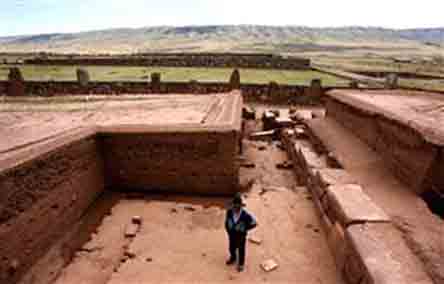
Archaeologists have uncovered the 1,300-year-old skeleton of a ruler or priest of the ancient Tiwanaku civilization, together with precious jewels inside a much-looted pyramid in western Bolivia. The bones are in very good condition and belong to either a ruler or a priest, Roger Angel Cossio, the Bolivian archaeologist who made the discovery, told Reuters on Wednesday. He said the tomb containing a diadem and a fist-sized carved pendant of solid gold survived centuries of looting by Spanish invaders and unscrupulous raiders who depleted Tiwanaku of many precious treasures.
"After so much looting ... miraculously this has stayed to tell us the history," Cossio said. "It¹s a complete body... next to it are jewels, offerings and a llama." The llama may have been a status symbol or a source of food for the journey to the afterlife, archaeologists said. The corpse was found in a niche carved inside the 15-yard-high (15-meter-high) Akapana pyramid, which was built around 1200 B.C. and is described by experts as one of the biggest pre-Columbian constructions in South America. At its peak, the city of Tiwanaku stretched over 1,480 acres (600 hectares) and had a population of more than 100,000, according to chief archaeologist Javier Escalante, who presented the findings on Wednesday at a news conference near the pyramid.
The Tiwanaku civilization spread throughout southwestern Bolivia and parts of neighboring Peru, Argentina and Chile from around 1500 B.C. to A.D. 1200. Although experts still have to do carbon dating to determine the age of the remains, archaeologists estimate they were buried 1,300 years ago, during the decline of the Tiwanaku empire. Cossio believes the remains belong to someone of importance in the Tiwanaku society. "Not just anyone would be buried under the Akapana pyramid," he said. In the 1900s, workers used the base of the pyramid as a quarry from which they extracted stones to build a rail line connecting the neighboring town of Guaqui with La Paz.
INCA CIVILIZATION
ShareThis
PYRAMID INDEX
SACRED PLACES AND TEACHINGS INDEX
ANCIENT CIVILIZATIONS INDEX
ALPHABETICAL INDEX OF ALL FILES
CRYSTALINKS HOME PAGE
PSYCHIC READING WITH ELLIE
2012 THE ALCHEMY OF TIME
|
|
|
|
Rispondi |
Messaggio 11 di 76 di questo argomento |
|
|
Tiwanaku
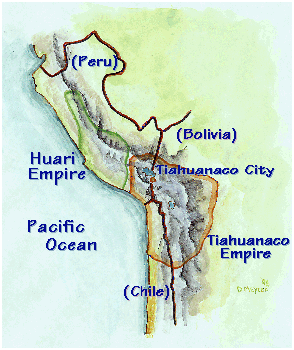
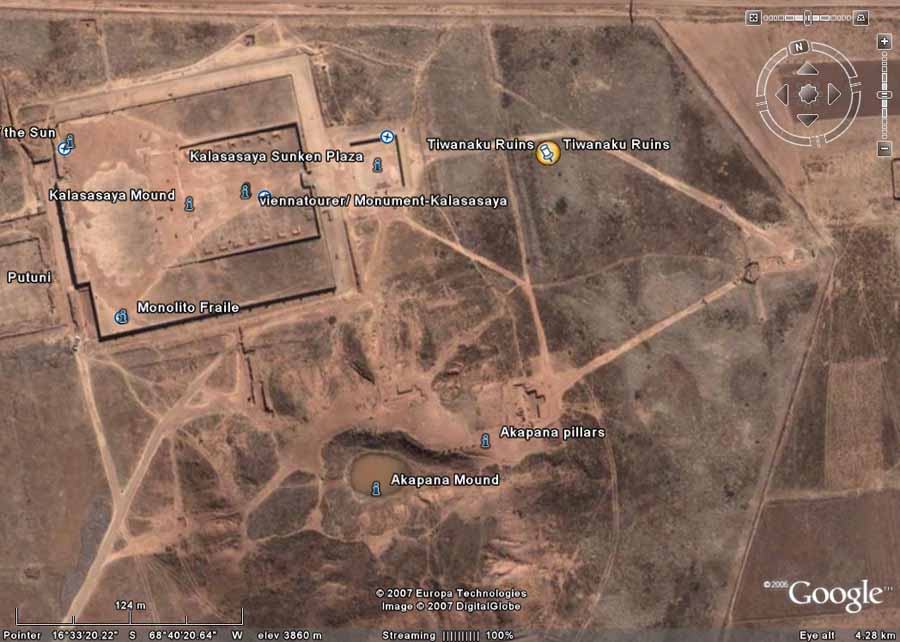
In the holograms of reality, Tiwanaku is another ancient civilization whose timeline came and went, leaving behind megalithic monuments that go without explanation as to their mathematical design and construction. Considered by some the oldest city in the world, much of Tiwanaku's creation defies the laws of physics and mathematics even by today's standards. Many monuments bear close resemblance to those created by other ancient cultures all over the planet, truly an overlap if one were to place hologram over hologram, to define the journey of humanity in time.
As with many other sacred sites throughout the planet Tiwanaku remains an enigma allowing researchers to speculate on its origins and purpose then parallel that with other ancient civilizations left behind by unknown beings surviving in time with great stone markers which bear clues to humanity's creation story. Gods, temples, idols, metaphors, all clues in a puzzle humanity is unraveling at this time of conscious awakening.
Background - Back Story
Tiwanaku is an important Pre-Columbian archaeological site in western Bolivia. It is recognized by Andean scholars as one of the most important precursors to the Inca Empire, flourishing as the ritual and administrative capital of a major state power for approximately five hundred years. The ruins of the ancient city state are near the south-eastern shore of Lake Titicaca in the La Paz Department, Ingavi Province, Tiwanaku Municipality, about 72 km (44 miles) west of La Paz.
The site was first recorded in written history by Spanish conquistador and self-acclaimed 'first chronicler of the Indies' Pedro Cieza de Leon. Leon stumbled upon the remains of Tiwanaku in 1549 while searching for the Inca capital Collasuyu. Some have hypothesized that Tiwanaku's modern name is related to the Aymara term taypiqala, meaning "stone in the center", alluding to the belief that it lay at the center of the world. However, the name by which Tiwanaku was known to its inhabitants has been lost, as the people of Tiwanaku had no written language.
Some believe Tiwanaku is the oldest city in the world. Others believe it was built by an extraterrestrial race who also created the Nazca Lines.
Cultural Development and Agriculture
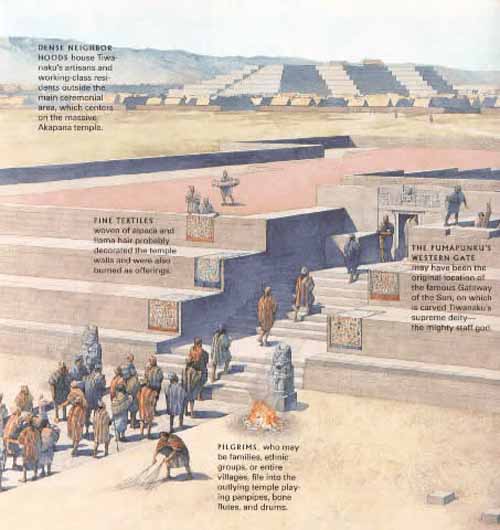
The area around Tiwanaku may have been inhabited as early as 1500 BC as a small agriculturally-based village. Most research, though, is based around the Tiwanaku IV and V periods between AD 300 and AD 1000, during which Tiwanaku grew significantly in power. During the time period between 300 BC and AD 300 Tiwanaku is thought to have been a moral and cosmological center to which many people made pilgrimages. The ideas of cosmological prestige are the precursors to Tiwanaku's powerful empire.
TiwanakuÕs location between the lake and dry highlands provided key resources of fish, wild birds, plants, and herding grounds for camelidae, particularly llamas. The Titicaca Basin is the most productive environment in the area with predictable and abundant rainfall, which the Tiwanaku culture learned to harness and use in their farming. As one goes further east, the Altiplano is an area of very dry arid land.
The high altitude Titicaca Basin required the development of a distinctive farming technique known as "flooded-raised field" agriculture (suka kollus). They comprised a significant percentage of the agriculture in the region, along with irrigated fields, pasture, terraced fields and qochas (artificial ponds) farming.
Artificially raised planting mounds are separated by shallow canals filled with water. The canals supply moisture for growing crops, but they also absorb heat from solar radiation during the day. This heat is gradually emitted during the bitterly cold nights that often produce frost, endemic to the region, providing thermal insulation.
Traces of landscape management were also found in the Llanos de Moxos region (Amazonian food plains of the Moxos).
Over time, the canals also were used to farm edible fish, and the resulting canal sludge was dredged for fertilizer. The fields grew to cover nearly the entire surface of the lake and although they were not uniform in size or shape, all had the same primary function.
Though labor-intensive, suka kollus produce impressive yields. While traditional agriculture in the region typically yields 2.4 metric tons of potatoes per hectare, and modern agriculture (with artificial fertilizers and pesticides) yields about 14.5 metric tons per hectare, suka kollu agriculture yields an average of 21 tons per hectare.
Significantly, the experimental fields recreated in the 1980s by University of Chicago's Alan Kolata and Oswaldo Rivera suffered only a 10% decrease in production following a 1988 freeze that killed 70-90% of the rest of the region's production. This kind of protection against killing frosts in an agrarian civilization is an invaluable asset. For these reasons, the importance of suka kollus cannot be overstated.
As the population grew occupational niches were created where each member of the society knew how to do their job and relied on the elites of the empire to provide all of the commoners with all the resources that would fulfill their needs.
Little is known of the 30,000 to 60,000 urban dwellers or of the city's crafts or administrative functions. We also know little about the storage system that was required for the bounty of surplus foods from the agricultural fields, the vast llama herds on the Poona, and the abundant fish caught in the lake. The core of this imperial capital was surrounded by a moat that restricted access to the temples and areas frequented by royalty.
Some occupations include agriculturists, herders, pastoralists, etc. Along with this separation of occupations, there was also a hierarchal stratification within the empire.
The elite of Tiwanaku lived inside four walls that were surrounded by a moat. This moat, some believe, was to create the image of a sacred island. Inside the walls there were many images of human origin that only the elites were privileged to, despite the fact that images represent the beginning of all humans not only the elite. Commoners may have only ever entered this structure for ceremonial purposes since it was home to the holiest of shrines.
Rise and Fall of Tiwanaku
The city and its inhabitants left no written history, and modern local people know little about the city and its activities. An archaeologically based theory asserts that around AD 400, Tiwanaku went from being a locally dominant force to a predatory state. Tiwanaku expanded its reaches into the Yungas and brought its culture and way of life to many other cultures in Peru, Bolivia, and Chile. However, Tiwanaku was not exclusively a violent culture. In order to expand its reach, Tiwanaku used politics to create colonies, negotiate trade agreements (which made the other cultures rather dependent), and establish state cults.
Many others were drawn into the Tiwanaku empire due to religious beliefs as Tiwanaku never ceased being a religious center. Force was rarely necessary for the empire to expand, but on the northern end of the Basin resistance was present. There is evidence that bases of some statues were taken from other cultures and carried all the way back to the capital city of Tiwanaku where the stones were placed in a subordinate position to the Gods of the Tiwanaku in order to display the power Tiwanaku held over many.
Among the times that Tiwanaku expressed violence were dedications made on top of building known as the Akipana. Here people were disemboweled and torn apart shortly after death and laid out for all to see. It is speculated that this ritual was a form of dedication to the gods. Research showed that one man who was dedicated was not a native to the Titicaca Basin, leaving room to think that dedications were most likely not of people originally within the society.
The community grew to urban proportions between AD 600 and AD 800, becoming an important regional power in the southern Andes. According to early estimates, at its maximum extent, the city covered approximately 6.5 square kilometers, and had between 15,000 - 30,000 inhabitants.
However, satellite imaging was used recently to map the extent of fossilized suka kollus across the three primary valleys of Tiwanaku, arriving at population-carrying capacity estimates of anywhere between 285,000 and 1,482,000 people.
The empire continued to grow, absorbing cultures rather than eradicating them. William H. Isbell states that "Tiahuanaco underwent a dramatic transformation between AD 600 and 700 that established new monumental standards for civic architecture and greatly increased the resident population."
Archaeologists note a dramatic adoption of Tiwanaku ceramics in the cultures who became part of the Tiwanaku empire. Tiwanaku gained its power through the trade it implemented between all of the cities within its empire.
The elites gained their status by control of the surplus of food obtained from all regions and redistributed among all the people. Control of llama herds became very significant to Tiwanaku, as they were essential for carrying goods back and forth between the center and the periphery. The animals may also have symbolized the distance between the commoners and the elites.
The elites' power continued to grow along with the surplus of resources until about AD 950. At this time a dramatic shift in climate occurred. A significant drop in precipitation occurred in the Titicaca Basin, with some archaeologists venturing to suggest a great drought. As the rain became less and less many of the cities furthest away from Lake Titicaca began to produce fewer crops to give to the elites.
As the surplus of food dropped, the elites power began to fall. Due to the resiliency of the raised fields, the capital city became the last place of production, but in the end even the intelligent design of the fields was no match for the weather. Tiwanaku disappeared around AD 1000 because food production, the empire's source of power and authority, dried up. The land was not inhabited again for many years. In isolated places, some remnants of the Tiwanaku people, like the Uros, may have survived until today.
Beyond the northern frontier of the Tiwanaku state a new power started to emerge in the beginning of the 13th century, the Inca Empire.
In 1445 Pachacuti Inca Yupanqui (the ninth Inca) began conquest of the Titicaca regions. He incorporated and developed what was left from the Tiwanaku patterns of culture, and the Inca officials were superimposed upon the existing local officials. Quechua was made the official language and sun worship the official religion. So, the last traces of the Tiwanaku civilization were integrated or deleted.
|
|
|
|
Rispondi |
Messaggio 12 di 76 di questo argomento |
|
Architecture
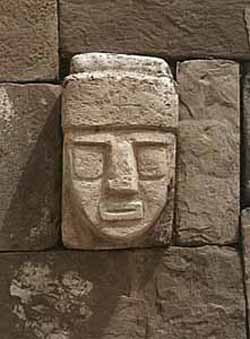
[Go to 53:27]
Tiwanaku monumental architecture is characterized by large stones of exceptional workmanship. In contrast to the masonry style of the later Inca, Tiwanaku stone architecture usually employs rectangular ashlar blocks laid in regular courses, and monumental structures were frequently fitted with elaborate drainage systems. The drainage systems of the Akapana and Pumapunku include conduits composed of red sandstone blocks held together by ternary (copper/arsenic/nickel) bronze architectural cramps. The I-shaped architectural cramps of the Akapana were created by cold hammering of ingots. In contrast, the cramps of the Akapana were created by pouring molten metal into I-shaped sockets.
The blocks have flat faces that do not need to be fitted upon placement because the grooves make it possible for the blocks to be shifted by ropes into place.
The main architectural appeal of the site comes from the carved images on the blocks along with carved doorways and giant stone monoliths. The stone used to build Tiwanaku was quarried and then transported 40 km or more to the city.
The most important edifice for dating purposes is the Kalasasaya ("Place of the Vertical Stones"). It is built like a stockade with 12 foot high columns jutting upward at intervals, each of these being carved into human figures.
The steps of the Kalasasaya (Temple), are each a
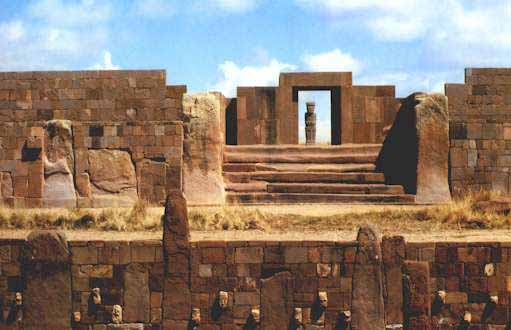
rectangular block of stone about 30 feet wide.
The megalithic entrance to the Kalasaya mound is here seen from the Sunken Courtyard viewing west. The Kalasaya stairway is a well-worn megalith, a single block of carved sandstone. Like the Kalasaya mound, the Sunken Courtyard is walled by standing stones and masonry infill. In this case the stones are smaller and sculptured heads are inset in the walls. Several stelae are placed in the center of the 30 m square courtyard.

The largest terraced step pyramid of the city, the Akapana, was once believed to be a modified hill, and has proven to be a massive human construction with a base 656 feet square and a height of 55.8 feet. It is aligned perfectly with the cardinal directions. Its base is formed of beautifully cut and joined facing stone blocks. Within the cut- stone retaining walls are six T- shaped terraces with vertical stone pillars, an architectural technique that is also used in most of the other Tiwanaku monuments. It originally had a covering of smooth Andesite stone, but 90% of that has disappeared due to weathering. The ruinous state of the pyramid is due to its being used as a stone quarry for later buildings at La Paz. Its interior is honeycombed with shafts in a complicated grid pattern, which incorporates a system of weirs used to direct water from a tank on top, going through a series of levels,and finally ending up in a stone canal surrounding the pyramid. On the summit of the Akapana there was a sunken court with an area 164 feet square serviced by a subterranean drainage system that remains unexplained.
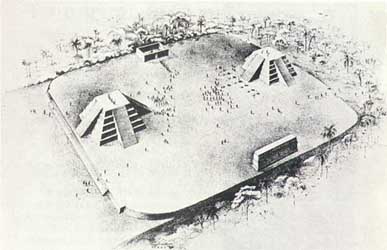
Associated with the Akapana are four temples: the Semi-subterranean, the Kalasasaya, the Putuni, and the Kheri Kala. The first of these, the Semi-subterranean Temple, was studded with sculptured stone heads set into cut-stone facing walls and in the middle of the court was located a now-famous monolithic stela. Named for archaeologist Wendell C. Bennett who conducted the first archaeological research at Tiwanaku in the 1930's, the Bennett Stela represents a human figure wearing elaborate clothes and a crown. The ancient Tiwanaku heartland is estimated to have been about 365,000, of whom 115,000 lived in the capital and satellite cities, with the remaining 250,000 engaged in farming, herding, and fishing.
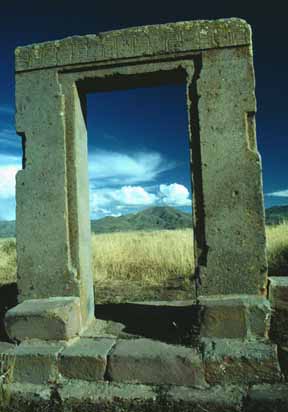
This megatlithic doorway is all that remains of the walls of a building on a small mound near the Kalasaya. Much of the readily accessible masonry at the ruin was used to construct the Catholic church in the village. A nearby railroad bridge also has Tiwanaku stone.
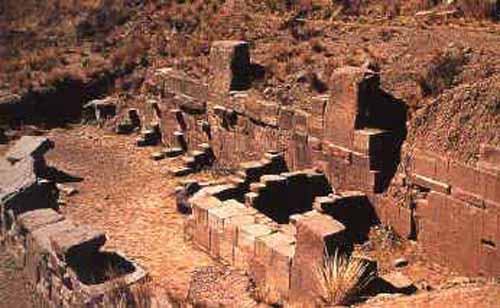
Adjacent to the sunken court, residences of the elite were revealed, while under the patio the remains of a number of seated individuals, believed to have been priests, faced a man with a ceramic vessel that displayed a puma-an animal sacred to the Tiwanaku. Ritual offerings of llamas and ceramics, as well as high-status goods made of copper, silver and obsidian were also encountered in this elite residential area. The cut-stone building foundations supported walls of adobe brick, which have been eroded away by the yearly torrential rains over the centuries.
In 1934 the Peruvianist Wendell C. Bennett carried out several excavations at Tiwanaku. Excavating in the Subterranean Temple he found two large stone images. One was a bearded statue. Depicted are large round eyes, a straight narrow nose and oval mouth. Rays of lightning are carved on the forehead. Strange animals are carved up around the head. It stands over 7 feet tall with arms crossed over an ankle- length tunic, which is decorated with pumas around the hem. Serpents ascend the figure on each side, reminding one of the Feathered Serpent culture-hero known as Quetzalcoatl in Central America.
Beside the bearded statue was a much larger statue Bennett's report as "the large monolithic statue" and is over 24 feet tall. It was sculpted out of red sandstone, and is covered with carved images of various kinds. He holds objects in each hand which are totally unidentifiable, although numerous interpretations have been suggested. The lower half of its body, which is covered with fish-scales (which upon close inspection are actually fish-heads). Immediately one recalls the Mesopotamian deity called Oannes, the man-fish amphibious being who conveyed special knowledge to ancient mankind. The statue has been removed from the site and now stands in a plaza in La Paz.
This monolithic piece of work has a number of designs scattered over its surface, many of which resemble the running winged-figures found on the Gate of the Sun, only with curled-up tails. The "Weeping God" is depicted on the sides of the head of the statue.
There are numerous other statues which have been found at Tiahuanacu, several of which have found their way into various museums. Most have the incomprehensible stiff designs scattered about on their surfaces in the typical Tiahuanacu style. Some are rather large, and others are small. Depictions of toxodons and several other extinct creatures are plentiful at Tiahuanacu. The images of these extinct animals are understandable on pottery and textiles, they could be copied by anyone from the stone monuments dotting the area.
In the northwest corner stands the Gateway of the Sun,
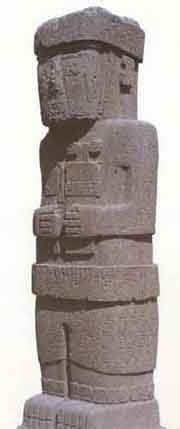
and in the southwest corner is The Idol.
This is one of two large anthropomorphic figures standings in the southwest corner of the Kalasasaya Temple. This one faces the entrance and is placed on the central axis. With the exception of the Sun Gate, it is the most picturesque of the sculptures at Tiahuanacu, since its 7-foot height is almost covered with hieroglyphic-like carvings. No one knows if these carvings represent a form of writing or are merely decorative. The figures resemble those on Easter Island.
The Akapana is the biggest platform on the site measuring 200 meters on each side and 17 meters tall and the largest ashlars of andesite or sandstone weigh over 100 tons.
Originally, the Akapana was thought to have been made from a modified hill, but recent studies have shown that most of the hill is man-made by taking dirt from the moat and packing it behind stone walls.
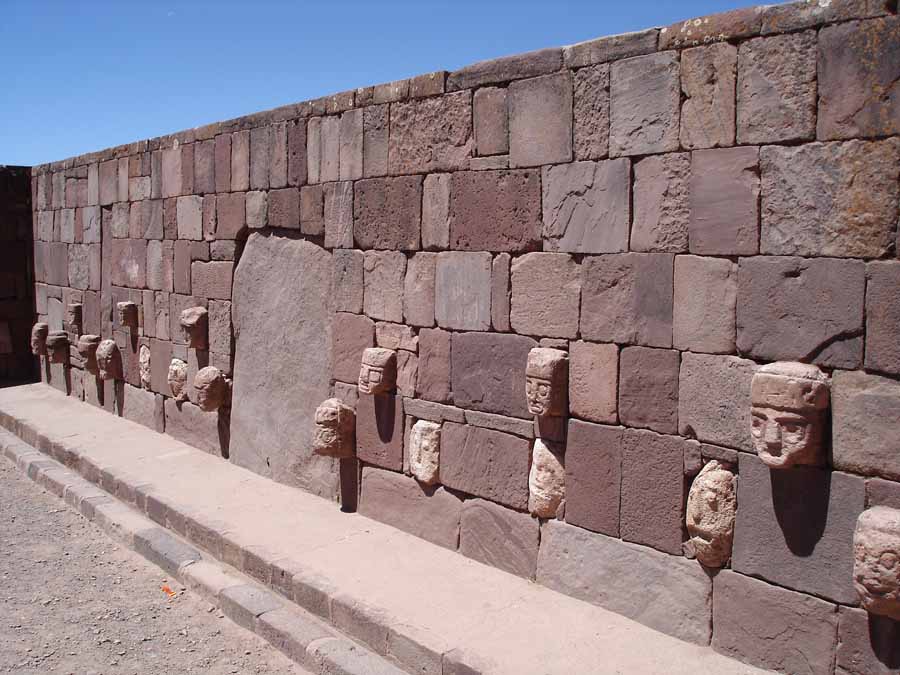
It is constructed from a mix of tall, upright, and small stones. There are staircases present on the east and west sides with a sunken court 50 meters long between them. Today the area where this would be is an indiscernible hole. The structure was possibly for the shaman-puma relationship or transformation. Tenon puma and human heads stud the upper terraces.
The Akapana East was built on the eastern side of early Tiwanaku and later became a boundary for the ceremonial center and the urban area. It was made of a thick prepared floor of sand and clay and supported a group of buildings. Yellow and red clay were used in different areas for what seems like aesthetic purposes. One major observation was that it was swept clean of all domestic refuse, signaling great importance to the culture.
The Kalasasaya is a large courtyard over three hundred feet long, outlined by a high gateway. It is located to the north of the Akapana and west of the Semi-Subterranean Temple. Within the courtyard is where explorers found the Gateway of the Sun, but it is contested today that this was not its original location.
|
|
|
|
Rispondi |
Messaggio 13 di 76 di questo argomento |
|
Near the courtyard is the Semi-Subterranean Temple; a square sunken courtyard thatÕs unique for its north-south rather than east-west axis. The walls are covered with tenon heads of many different styles postulating that it was probably reused for different purposes over time. It was built with walls of sandstone pillars and smaller blocks of Ashlar masonry. There are many more colossal stone statues, gateways and blocks including one that is 7.5 meters tall weighing well over 10 tons.
Within many of the sites structures are impressive gateways; the ones of monumental scale being placed on artificial mounds, platforms, or sunken courts. Many gateways show iconography of "Staffed Gods" that also spreads to some oversized vessels, indicating an importance to the culture. This iconography is most present on the The Gateway of the Sun.
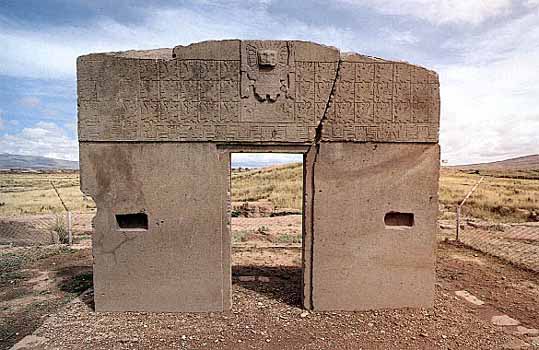
The Gate of the Sun
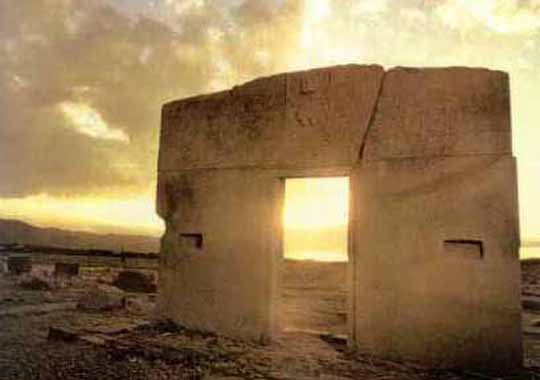
Winter Solstice
The Gate of the Sun is a stone gateway constructed by the Tiwanaku culture. It is located near Lake Titicaca at about 3,825 m above sea level in La Paz, Bolivia. The gate is approximately 9.8 ft (3.0 m) tall and 13 ft (4.0 m) wide. It was originally constructed by a single piece of stone. The weight is estimated to be 10 tons.
When the gate was originally found, it was lying face down and had a large crack. It stands in the place where it was found, although it is believed that this was not its original location. Gate of the Sun is a valuable monument to the history of art. Some elements of their iconography spread throughout Peru and parts of Bolivia; the engravings that decorate the gate has some astronomic connotations. There have been innumerable interpretations of the inscriptions on Gate of the Sun; many of them believe that it was used as a calendar.
The lintel is carved with 48 winged effigies each in a square, 32 with human faces, and 16 with condor's heads. surrounding a central figure. There are 32 effigies with human faces and 16 with condor's heads. All looked to the central figure, whose identity is still an enigma. It is a figure of a man with the head surrounded by 24 stripes that represent rays shooting from his face. The styled staffs held by the figure symbolize thunder and lightning. Some historians believe that the central figure represents the Sun God by the rays of his head, while others identified it with the Inca god Viracocha.
This huge monument is hewn from a single block of stone, and some believe that the strange symbols might represent a calendar, the oldest in the world. A huge monolithic figure, facing east in the direction of sunrise, stands as silent witness to an unknown civilization established around 2200 years ago.
The Gateway of the Sun and others located at Pumapunku are all not complete, missing part of a typical recessed frame known as a chambranle and having sockets for clamps present for additions. These architectural examples, as well as the recently discovered Akapana Gate have a unique detail and skill in stone-cutting that reveal a knowledge of descriptive geometry. The regularity of elements suggest be part of a system of proportions.
Many theories for Tiwanaku's architecture construction have been proposed. One is that they used a lukÕa which is a standard measurement of about sixty centimeters. Another argument is for the Pythagorean Ratio. This idea calls for right triangles at a ration of five to four to three used in the gateways to measure all parts. Lastly Protzen and Nair argue that Tiwanaku had a system set for individual elements dependent on context and composition. This is shown in the construction of similar gateways ranging from diminutive to monumental size proving that scaling factors did not affect proportion. With each added element, the individual pieces shifted to fit together.
Throughout their imperial reign, the Tiwanaku shared domination of the Middle Horizon with the Wari. Their culture rose and fell around the same time and was centered 500 miles north in the southern highlands of Peru. The relationship between the two empires is unknown either being cooperative or antagonistic. Definite interaction between the two is proved by their shared iconography in art. Significant elements of both of these styles, the split eye, trophy heads, and staff-bearing profile figures, for example, seem to have been derived from that of the earlier Pukara culture in the northern Titicaca Basin.
The Tiwanaku created a powerful ideology, using previous Andean icons that spread throughout their sphere of influence using extensive trade routes and shamanistic art. Tiwanaku art consisted of legible, outlined figures depicted in curvilinear style with a naturalistic manner, while Wari art used the same symbols in a more abstract, rectilinear style with a militaristic manner.
Art
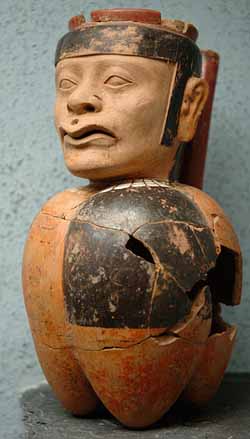
Tiwanaku sculpture is comprised typically of blocky column-like figures with huge, flat square eyes, and detailed with shallow relief carving. They are often holding ritual objects like the Ponce Stela or the Bennett Monolith. Some have been found holding severed heads such as the figure on the Akapana, possibly a puma-shaman. These images suggest ritual human beheading, which correlate with the discovery of headless skeletons found under the Akapana.
Ceramics and textiles were also present in their art, composed of bright colors and stepped patterns. An important ceramic artifact is the kero, a drinking cup, that was ritually smashed after ceremonies and placed in burials. However, as the empire expanded, ceramics changed in the society.
The earliest ceramics were "coarsely polished, deeply incised brownware and a burnished polychrome incised ware". Later the Qeya style became popular during the Tiwanaku III phase "Typified by vessels of a soft, light brown ceramic paste". These ceramics included libation bowls and bulbous bottom vases.
Examples of textiles are tapestries and tunics. The objects typically depicted herders, effigies, trophy heads, sacrificial victims, and felines. The key to spreading religion and influence from the main site to the satellite centers was through small portable objects that held ritual religious meaning. They were created in wood, engraved bone, and cloth and depicted puma and jaguar effigies, incense burners, carved wooden hallucinogenic snuff tablets, and human portrait vessels. Like the Moche, Tiwanaku portraits had individual characteristics in them.
Pumapunku
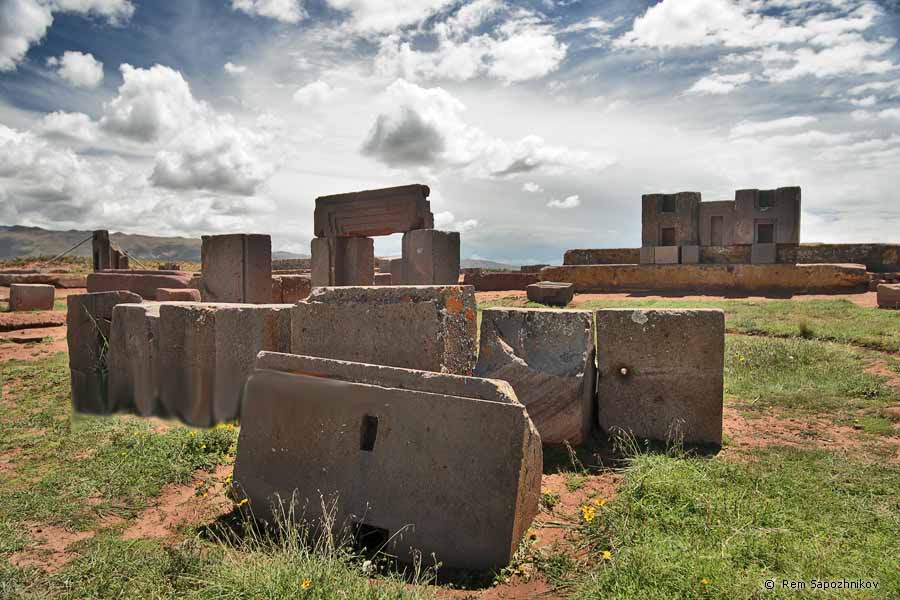
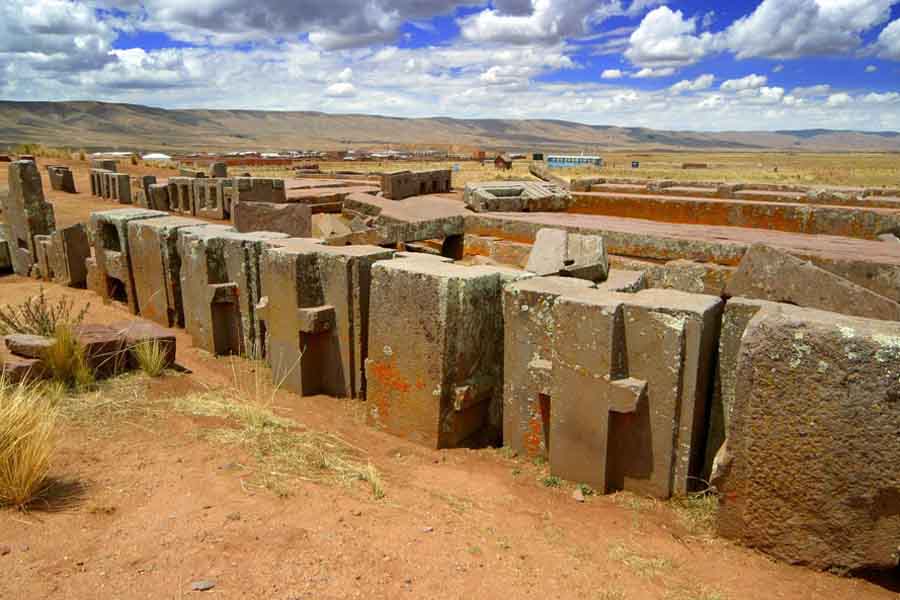
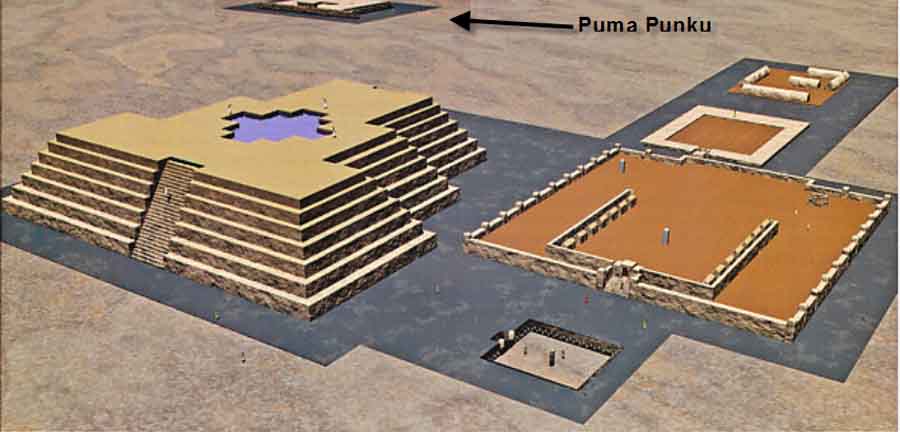
Pumapunku is a large temple complex located in Tiwanaku, Bolivia. In Aymara, the name Puma Punku means, "The Door of the Cougar". It is situated near the south eastern shore of Lake Titicaca, and sits on a plateau in the Andes at roughly 12,600 feet elevation.
Pumapunku's construction is generally argued to have taken place beginning around 200 BC. The temple itself stood at least 56 feet tall and took up an area of 164 square feet while the overall site and the surrounding constructions, namely the pyramid which the ruins sit on, extend over half a kilometer in length.
At its peak, Pumapunku is thought to have been unimaginably wondrous, adorned with polished metal plaques, brightly colored ceramic and fabric ornamentation, and trafficked by costumed citizens, elaborately dressed priests and elites decked in exotic jewelry.
Understanding of this complex is limited due to its age, the lack of a written record, and the current deteriorated state of the structures due to looting, stone mining for building stone and railroad ballast and natural weathering. The technological innovation and the beautiful stonework that went into the creation of Pumapunku have drawn comparisons to the Egyptian pyramids, Stonehenge and Easter Island.
Determining the age of these ruins has been a focus of researchers since the site's discovery. Currently archaeologists date the beginning of the Tiwanaku culture to some time around 1500 BC, and the construction of the Pumapunku complex to around 200 BC.
Previously, in the early 1900s, Bolivian engineer Arthur Posnansky, based on astronomical alignments, concluded that Tiwanaku was constructed as early as 15,000 BC (17,000 BP), possibly even older and was not an original construction of the Tiwanaku.
In the 1930s, German astronomers from the University of Bonn; Rolf Muller, Hanns Lundendorff, Friederich Becker, and Arnold Kohlshutter came to conclusions similar to Posnansky's estimate. However, as noted by Kolata subsequent archaeological research has found a complete lack of any physical evidence, including prehistoric tools and dated midden deposits, for any occupation of the Tiwanaku site as old as argued by Posnansky and the German astronomers either at the Tiwanaku Site, near it, or in direct association with the Pumapunku complex despite decades of intensive excavation and research.
The processes and technologies involved in the creation of these temples are still not fully understood by modern scholars. Our current ideas of the Tiwanaku culture hold that they had no writing system and also that the invention of the wheel was most likely unknown to them.
The architectural achievements seen at Pumapunku are striking in light of the presumed level of technological capability available during its construction. Due to the monumental proportions of the stones, the method by which they were transported to Pumapunku has been a topic of interest since the temple's discovery.
The stones are argued to have been transported up a steep incline from a quarry near Lake Titicaca roughly 20 miles away. Some of the blocks are said to weigh in the range of 100Ð130 tons.
One notable block has been measured at 36 feet long, 16 feet wide and 6 feet thick. Archaeologists argue that this was accomplished by the large labor force of ancient Tiwanaku. Several theories have been proposed as to how this labor force transported the stones although these theories remain speculative. Two of the more common proposals involve the use of llama skin ropes and the use of ramps and inclined planes.
|
|
|
|
Rispondi |
Messaggio 14 di 76 di questo argomento |
|
In assembling the walls of Pumapunku, each stone was finely cut to interlock with the surrounding stones and the blocks fit together like a puzzle, forming load-bearing joints without the use of mortar. One common engineering technique involves cutting the top of the lower stone at a certain angle, and placing another stone on top of it which was cut at the same angle.
The precision with which these angles have been utilized to create flush joints is indicative of a highly sophisticated knowledge of stone-cutting and a thorough understanding of descriptive geometry.
Many of the joints are so precise that not even a razor blade will fit between the stones.
Much of the masonry is characterized by accurately cut rectilinear blocks of such uniformity that they could be interchanged for one another while maintaining a level surface and even joints.
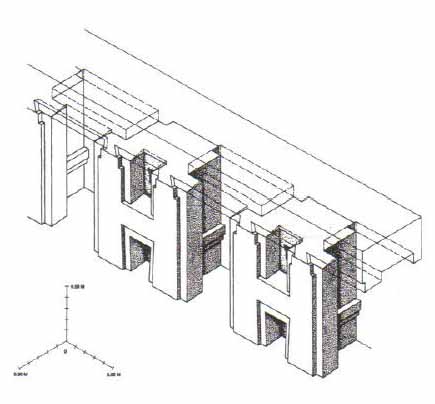
The blocks were so precisely cut as to suggest the possibility of prefabrication and mass production, technologies far in advance of the TiwanakuÕs Incan successors hundreds of years later.
Tiwanaku engineers were also adept at developing a civic infrastructure at this complex, constructing functional irrigation systems, hydraulic mechanisms, and waterproof sewage lines.
To sustain the weight of these massive structures, Tiwanaku architects were meticulous in creating foundations, often fitting stones directly to bedrock or digging precise trenches and carefully filling them with layered sedimentary stones to support large stone blocks.
Modern day engineers argue that the base of the Pumapunku temple was constructed using a technique called layering and depositing. By alternating layers of sand from the interior and layers of composite from the exterior, the fills would overlap each other at the joints, essentially grading the contact points to create a sturdy base.
Notable features at Pumapunku are I-shaped architectural cramps, which are composed of a unique copper-arsenic-nickel bronze alloy. These I-shaped cramps were also used on a section of canal found at the base of the Akapana pyramid at Tiwanaku.
These cramps were used to hold the blocks comprising the walls and bottom of stone-line canals that drain sunken courts. I-cramps of unknown composition were used to hold together the massive slabs that formed Pumapunku's four large platforms.
In the south canal of the Pumapunku, the I-shaped cramps were cast in place. In sharp contrast, the cramps used at the Akapana canal were fashioned by the cold hammering of copper-arsenic-nickel bronze ingots.The unique copper-arsenic-nickel bronze alloy is also found in metal artifacts within the region between Tiwanaku and San Pedro de Atacama during the late Middle Horizon around A.D. 600-900.
The Pumapunku is another man-made platform built on an east-west axis like the Akapana. Its main difference from other structures at the cite is its T-shaped construction. It measures 150 meters on each side and 5 meters tall. The heaviest stone block weighs 131 tons and was dragged from a quarry 10 km away. One of the sunken temples includes projecting heads of volcanic tuff which may imply remote Chavin influence.
It is theorized the Pumapunku complex as well as its surrounding temples, the Akapana pyramid, Kalasasaya, Putuni and Kerikala functioned as spiritual and ritual centers for the Tiwanaku. This area might have been viewed as the center of the Andean world, attracting pilgrims from miles away to marvel in its beauty.
These structures transformed the local landscape; Pumapunku was purposely integrated with Illimani mountain, a sacred peak that the Tiwanaku possibly believed to be home to the spirits of their dead. This area was believed to have existed between heaven and Earth.
The spiritual significance and the sense of wonder would have been amplified into a "mind-altering and life-changing experience" through the use of hallucinogenic plants. Recent excavations have unearthed hallucinogenic cacti, other psychedelic entheogens, drug paraphernalia, snuffing kits, and mummified shamans with assortments of drugs and medicines. Examinations of hair samples exhibit remnants of psychoactive substances in many mummies found in the Tiwanaku aria, even those of babies as young as 1 year of age, demonstrating the importance of these substances to the local people's spirituality.
As was characteristic of civilizations around this time, the Tiwanaku actively incorporated human sacrifice into their culture. The remains of dismembered bodies have been found throughout the area. Ceramic artifacts depict imagery of warriors, masked with puma skulls, decapitating their enemies and holding trophy skulls, adorned with belts of human heads with their tongues torn out.
The Tiwanaku civilization and the use of these temples appears to some to have peaked from around 700 AD to 1000 AD, by which point the temples and surrounding area may have been home to some 400,000 people. By this point, an extensive infrastructure had been developed with a complex irrigation system running over 30 square miles to support potatoes, quinoa, corn and other various crops. At its peak the Tiwanaku culture dominated the entire Lake Titicaca basin as well as portions of Bolivia and Chile.
The culture in question seems to have dissolved rather abruptly some time around 1000 AD and researchers are still seeking answers as to why. A likely scenario involves rapid environmental change, possibly involving an extended drought. Unable to support the massive crop yields necessary for their large population, the Tiwanaku are argued to have scattered into the local mountain ranges only to disappear shortly thereafter.
Religion - Viracocha
As these people had no written language, what is known of their religious beliefs are based on archaeological interpretation and some myths, which may have been passed down to the Incas and the Spanish. They seem to have worshipped many gods, perhaps centered around agriculture.
One of the most important gods was Viracocha, the god of action, shaper of many worlds, and destroyer of many worlds. He created people, with two servants, on a great piece of rock. Then he drew sections on the rock and sent his servants to name the tribes in those areas.
Viracocha, like Quetzalcoatl, is described in many forms - human and a god. Both were sometimes described as a Caucasian, a bearded man in some writings, with white skin, hair on the face and beautiful emerald eyes in others wearing long white robes and sandals, carrying a staff, with a cougar lying at his feet.
Viracocha, as the feathered serpent god, is one of the great mysteries of ancient American cultures. He was called Kukulkan by the Mayas, Quetzalcoatl by the Aztec, Viracocha by the Incas Gucumatz in central America, Votan in Palenque and Zamna in Izamal.
By now I am sure you have figured out that one god played all of the roles (male and female) in all of the ancient civilization creation myths. The iconography is always the same or overlaps.
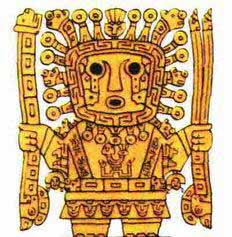
Viracocha was generally depicted as having staves in both of his hands and an aureole, suggests the qualities of a sun god, perhaps holding thunderbolts or lightning bolts associated with Zeus head of the Greek Pantheon of Gods.
The staves might suggest Viracocha's distant ancestry from the nearly thousand years older Chaviacuten sky god in North Peru. His attendants were ranking deities in the shapes of cougar, condor, falcon and snake. Viracocha was worshipped as the main god in Huari as well. There his characteristics were apparently more militant. A head of Tiahuanaco state functioned both as a king and the arch-priest and he was revered as Viracocha's embodiment on Earth.
In Tiwanaku they believed Viracocha allegedly created humans out of rock and brought life to them through the earth. He created giants to move the massive stones that comprise much of their archaeology, but then grew unhappy with the giants and created a flood to destroy them, much like the Flood Stories of Creation, and a metaphor for the flow of the collective unconsciousness or the grids that create the reality (illusion) of our experience.
Viracocha, as a good deity, came to the Andes to restore civilization, culture and knowledge after the Flood. As with nearly all ancient peoples, Inca legend claims that the original people were flood survivors who by hiding in a hollow up on a very high mountain peak, were saved and repopulated the Earth.
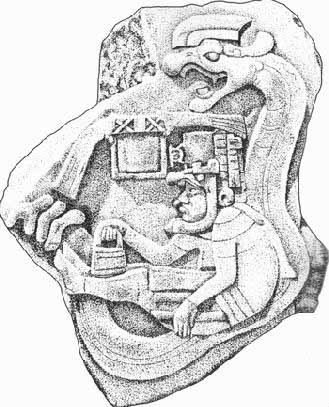
Gods with Water Buckets
The Serpent Represents Human DNA, Chromosomes ---> Fetus = Creation
Viracocha is depicted by a water symbol that of the serpent or snake. This is not unlike other myths which mention amphibious gods who came from the heavens (higher frequencies of light), went into the sea (collective unconscious or grids), then moved onto the land (physical reality) and created human civilizations.
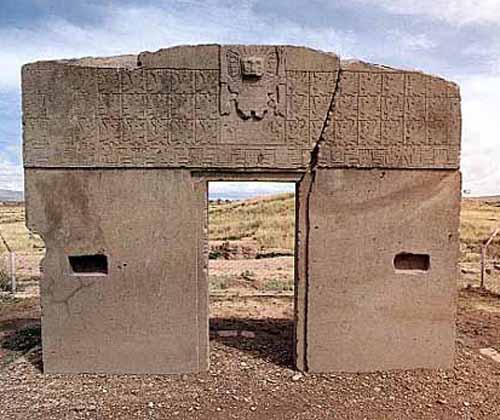
Viracocha is carved into the most famous gateway, the Gateway of the Sun, to overlook his people and lands. The Gateway of the Sun is a monolithic structure of regular, non-monumental size. Its dimensions suggest that other regularly-sized buildings existed at the site.
It was found at Kalasasaya, but due to the similarity of other gateways found at Pumapunku it was probably originally part of a series of doorways there. It is recognized for its singular, great frieze which is thought to be some main deity figure surrounded by either calendar signs or natural forces for agricultural worship. Along with Viracocha, another statue is in the Gateway of the Sun.
This statue, many believe, is associated with the weather - a celestial high god that personified various elements of natural forces intimately associated the productive potential of altiplano ecology - the sun, wind, rain, hail - in brief, a personification of atmospherics that most directly affect agricultural production in either a positive or negative manner".
This statue is more complicated than Viracocha in that it has twelve faces covered by a solar mask and at the base thirty running or kneeling figures. Some scientists believe that this statue is a representation of the calendar with twelve months and thirty days in each month.
Viracocha was said to use holy relics such as four skulls of wisdom. When brought together in ceremonial rites, these four skulls delivered enlightenment to the worthy. The power of the skulls was also used to vanquish their enemies by bringing fire from the skies. This sounds a lot like the prophecy of 12 crystal skulls around 1 bought together at the end of time.
|
|
|
|
Rispondi |
Messaggio 15 di 76 di questo argomento |
|
Legends of the Aymara Indians say that the Creator God Viracocha rose from Lake Titicaca during the time of darkness to bring forth light. Viracocha was a storm god and a sun god who was represented as wearing the sun for a crown, with thunderbolts in his hands, and tears descending from his eyes as rain. He wandered the Earth disguised as a beggar and wept when he saw the plight of the creatures he had created, but knew that he must sustain them. Viracocha made the earth, the stars, the sky and mankind, but his first creation displeased him, so he destroyed it with a flood and made a new, better one, taking to his wanderings as a beggar, teaching his new creations the rudiments of civilization, as well as working numerous miracles. Viracocha eventually disappeared across the Pacific Ocean (by walking on the water), setting off near Manta Ecuador, and never returned. It was thought that Viracocha would re-appear in times of trouble. References are also found of a group of men named the suncasapa or bearded ones. They were the mythic soldiers of Viracocha, or his angelic warriors.
Across from the ruins of Ollantaytambo in the Urubamba Valley stands a sacred mountain
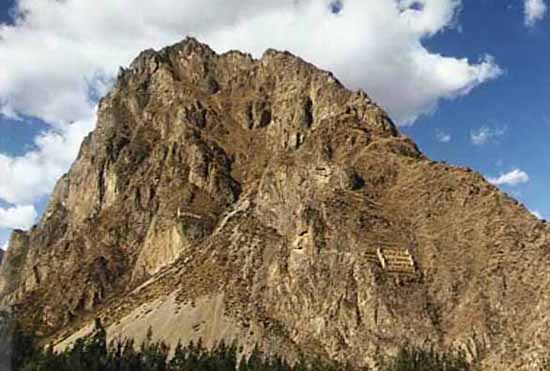
believed to have the profile of Viracocha, the Inca sun god, carved into the stone.
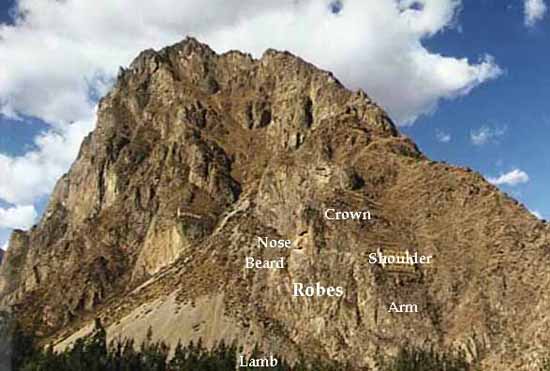
When the sun strikes this profile of Viracocha during the winter solstice, the mineral content of the mountain reflects and refracts the rays. The Inca believed that this was a sign verifying the deity of Viracocha. The solstices were sacred days for the Inca since so much of their culture was based on planting seasons. The buildings to the right and to the left were constructed by the Inca to store corn as food for winters and as offerings to Viracocha. the winter solstice further links with and of a cycle on December 1, 2012 in the Mayan Calendar.
All myths and legends are filled with metaphors and have some basis in fact. One has only to read behind the symbolism of the creational story, then compare it to other creational myths to see how they are all similar in design. In almost all cases creational gods leave, promising to return one day. That day is usually associated with the dawning of a Golden Age when humanity finds peace and moves to another level of consciousness.
The Legend of Creation - 1- Myths about the Ayar brothers
Four pairs of brothers-sisters, created by Viracocha to rule the world, left the cave of Mountain Pacariqtambo. The whole world was living in an uncivilized and ignorant manner. The newcomers began by organizing the mankind and divided people into ten large communities. Leading the tribes the brothers set off in search of enough fertile land to sustain themselves. They carried Sunturpaucar, a long staff adorned with colorful feathers, a cage with a sun-bird who could give good advice and other sacred objects in front of them.
Making shorter and longer stops they moved towards Cuzco. In the course of the long journey the group became smaller: the rivaling brothers confined one of their companions to a cave, two others wished to break away but were turned into stones. The only surviving brother, Ayar Manco, also known as Manco Capak, accompanied by his sister and wife Mama Ocllo and his brothers' wives, founded the city of World Pole in the name of Viracocha the Creator and Inti the Sun God, and settled there with his people.
The Legend of Creation - 2 - Myth of Manco Capak and Mama Ocllo
A long time ago when the world was filled with savages, misery and poverty, a brother and a sister, who were also a married couple - Manco Capak and Mama Ocllo - left Lake Titicaca. Inti, the sun god sent them to refine the surrounding peoples. Inti gave them a golden stick for testing the land for cultivation and then settling in a suitable place. The journey took a long time. Eventually, in the Cuzco Valley the golden stick disappeared into the ground, and they could start with their mission. Manco Capak taught his people the cultivation and irrigation of land and handicrafts. Mama Ocllo taught the women spinning, weaving and sewing. The tribe of Manco Capak was called Hanan Cuzco (Higher Cuzco). The relatives of Mama Ocllo were called Hurin Cuzco (Lower Cuzco). The city and the state was founded in the name of Viracocha and Inti the sun god.
Other Pre-Inca Gods and Goddesses
Apu Inti (Sun God)
Originally acknowledged by Manco Capac, the first Inca, Apu Inti became the keystone in the Incan pantheon of earth-oriented deities. He was the most magnificent creation of Viracocha and the mythological father of the royal Inca line (proposed by Manco Capac, one may surmise, to achieve a status of heavenly mandate). Honored in an array of temples spanning the empire, Apu Inti was worshipped with sacrifice (animal and human) and prayers to golden idols. Ceremonies were conducted in his praise at sunrise and sunset, with fear sweeping the empire during solar eclipses. The Incas, receiving his gift of light and life, referred to themselves as children of the sun.
Manco Capac is sometimes referred to in legend as the Mythical Father of the Incas. According to the most frequently told story, four brothers, Manco Capac, Ayar Anca, Ayar Cachi, and Ayar Uchu, and their four sisters, Mama Ocllo, Mama Huaco, Mama Cura (or Ipacura), and Mama Raua, lived at Paccari-Tampu [tavern of the dawn], several miles distant from Cuzco. They gathered together the tribes of their locality, marched on the Cuzco Valley, and conquered the tribes living there. Manco Capac had by his sister-wife, Mama Ocllo, a son called Sinchi Roca (or Cinchi Roca).
Authorities concede that the first Inca chief to be a historical figure was called Sinchi Roca (c.1105?c.1140). Thus the foundation for an empire was laid. Another legend relates that the Sun created a man and a woman on an island in Lake Titicaca. They were given a golden staff by the Sun, their father, who bade them settle permanently at whatever place the staff should sink into the earth. At a hill overlooking the present city of Cuzco the staff of gold disappeared into the earth. They gathered around them a great many people and founded the city of Cuzco and the Inca state.
Chiqui Illapa (Thunder God)
Second only to Apu Inti, Chiqui Illapa was a magnanimous figure in Incan lore. Hailing rain down from the celestial river (the Milky Way), Illapa fed the empire. Incan legend asserts that he would crack his sister's water jug with a slingshot, reverberating the echoes of thunder as aqueous elixir spilled forth from the sky, showering the parched lands below. He was associated with Keypachu, the upper kingdom of heaven, and was worshipped throughout the growing season. Interestingly, any male child born during a thunderstorm was declared a priest of Chiqui Illapa, an exalted position in Incan society and within the priestly class itself.
Mamaquilla (Mother Moon)
First acknowledged by Inca Yapanqui, successor of Manco Capac, Mamaquilla was wife of the sun and timekeeper of the heavens. As the Incan calendar revolved around the lunar month, she was critical to the maintenance of a calendrical system that would ensure proper adherence to planting and harvesting seasons. She was represented with idols of silver, complementing the gold of her luminary husband.
Yakumama (Mother Water)
Yakumama was believed to control subterranean and mountain streams, blessing the fields with nourishment and springing fresh water from the earth. The complement of Chiqui Illapa, she was associated with ukupacha, the lower kingdom of heaven.
Mamacocha (Mother Sea)
A regional deity, Mamacocha was important to ayllus of the Peruvian coast, where she maintained the fertility of the sea. She was honored with conch shells, which were more valuable in this region than gold or silver.
Pachakama (Earth Mother)
Pachakama was also a regional deity, important to the Andean highlanders. She was ascribed the role of ensuring the fertility of soil and seed in the harsh mountain climates.
Stars
In the tradition of celestial deities, stars were thought to possess spirits that breathed life into earthly beings. Several constellations were also recognized as bearing agricultural import, such as the Pleiades, the "Seven Sisters" who preserved the seed, and the "Great Lizard", who appeared in the west during planting season and buried his head in the east at harvest time.
Waca
Waca were the family gods, or, synonymously, the shrines in which the family gods were worshipped. They were honored with more regularity than any deity of the state-recognized pantheon, as they wielded direct control over the prosperity of the ayllu. Wacas took a variety of forms, the most common being mountains, streams, caves, trees, or roads. Idols appropriate to their form were worshipped on a daily basis to appease them and avert the evocation of manevolence. Curiously, oddities such as twins, abnormal plants, and disfigured animals were also considered Wacas. In addition to the Waca of the kin group, individuals also had a personal guarding spirit of similar significance.
Further Religious Practices
Evidence also points to a system of ancestor worship at Tiwanaku. The preservation, use, and reconfiguration of mummy bundles and skeletal remains, like the later Inca, may suggest that this is the case.
Later cultures within the area made use of large "above ground burial chambers for the social elite, known as "chullpas". Similar, though smaller, structures were found within the site of Tiwanaku. Kolata suggests that, like the later Inka, the inhabitants of Tiwanaku may have practiced similar rituals and rites in relation to defunct. The Akapana East Building has evidence of ancestor burial. In comparison to the brutal treatment of the dead on top of the Akapana, the human remains at Akapana East seem to be much less for show and more so for proper burial. The skeletons show many cut marks that were most likely made by removing the flesh after death. Then these individuals were bundled up and buried rather than left out in the open.
Archaeology
Much of the architecture of the site is in a poor state of preservation, having been subjected to looting and amateur excavations attempting to locate valuables since shortly after Tiwanaku's fall. This destruction continued during the Spanish conquest and colonial period, and during 19th century and the early 20th century, and has included quarrying stone for building and railroad construction and target practice by military personnel.
Another issue for archaeologists is the lack of standing buildings at the modern site. Only public, non-domestic foundations remain, with poorly reconstructed walls. The ashlar blocks used in many of these structures were mass-produced in similar styles so that they could possibly be used for multiple purposes. Throughout the period of the site certain buildings changed purposes causing a mix of artifacts that are found today.
Detailed study of Tiwanaku began on a small scale in the mid-nineteenth century. In the 1860s, Ephraim George Squier visited the ruins and later published maps and sketches completed during his visit. German geologist Alphons StŸbel spent nine days in Tiwanaku in 1876, creating a map of the site based on careful measurements. He also made sketches and created paper impressions of carvings and other architectural features.
A book containing major photographic documentation was published in 1892 by engineer B. von Grumbkow. With commentary by archaeologist Max Uhle, this was the first in-depth scientific account of the ruins.
In the 1960s, an attempt was made at restoring the site, but by very uninformed parties. The walls pictured to the right, of the Kalasasaya, are almost all reconstruction. The original stones making up the Kalasasaya would have resembled a more "Stonehenge" like style, spaced evenly apart and standing straight up.
Unfortunately, the parties that made the reconstructions decided to make the Kalasasaya be enclosed by a wall that they themselves built. Ironically enough, the reconstruction itself is actually much poorer quality stoneworking than the people of Tiwanaku were capable of. It should also be noted that the Gateway of the Sun, that now stands in the Kalasasaya, is not in its original location, having been moved sometime earlier from its original location, which is unknown.
Modern, academically-sound archaeological excavations were performed from 1978 through the 1990s by University of Chicago anthropologist Alan Kolata and his Bolivian counterpart, Oswaldo Rivera. Among their contributions are the rediscovery of the suka kollus, accurate dating of the civilization's growth and influence, and evidence for a drought-based collapse of the Tiwanaku civilization.
Archaeologists like Paul Goldstein argue that the Tiwanaku empire ranged outside of the altiplano area and into the Moquegua Valley in Peru. Excavations at Omo settlements show signs of similar architecture characteristic of Tiwanaku such as a temple and terraced mound. Evidence of similar types of cranial deformation in burials between the Omo site and the main site of Tiwanaku is also being used for this argument.
Lukurmata
Lukurmata was an important secondary site near Lake Titicaca in Bolivia. First established nearly two thousand years ago, it grew to be a major ceremonial center in the Tiwanaku state, a polity that dominated the south-central Andes from a.d. 400 to 1200. After the Tiwanaku state collapsed, Lukurmata rapidly declined, becoming once again a small village. The site also shows evidence of extensive occupation that pre-dates the Tiwanakan civilization.
Present Day
Today Tiwanaku is a UNESCO world heritage site, and is administered by the Bolivian government.
Recently, the Department of Archaeology of Bolivia (DINAR, directed by Javier Escalante) has been conducting excavations on the Akapana pyramid. The Proyecto Arqueologico Pumapunku-Akapana (PAPA, or Pumapunku-Akapana Archaeological Project) run by the University of Pennsylvania, has been excavating in the area surrounding the pyramid for the past few years, and also conducting Ground Penetrating Radar surveys of the area.
In previous years, an archaeological field school offered through Harvard's Summer School Program, conducted in the residential area outside the monumental core, has provoked controversy amongst local archaeologists. The program was directed by Dr. Gary Urton of Harvard, expert in quipu, and Dr. Alexei Vranich of the University of Pennsylvania.
The controversy had to do with fact that permission to excavate Tiwanaku, being such an important site, is only provided to certified professional archaeologists and rarely to independent Bolivian scholars who scarcely can present proof of funding to carry on archaeological research. On that occasion permission was given to Harvard's Summer School to allow a team mostly composed of untrained students to dig the site. The controversy, charged with nationalistic and political undertones that characterized the archaeology of Tiwanaku faded rapidly without any response from the directors, however, the project did not continue in subsequent years.
Because nearby quarries are lacking, scholars marvel at the large blocks used to construct stone structures at Tiwanaku. The red sandstone used in the pyramid have been determined by petrographic analysis to come from a quarry 10 kilometers away - a remarkable distance considering that one of the stones alone weighs over 130 tons. The green andesite stones that were used to create the most elaborate carvings and monoliths originate from the Copacabana peninsula, located across Lake Titicaca. One theory is that these giant andesite stones, which weigh up to 40 tons were transported some 90 kilometers across Lake Titicaca on reed boats, then laboriously dragged another 10 kilometers to the city.
In 2009 state-sponsored restoration work on the Akapana pyramid was halted due to a complaint from UNESCO. The restoration had consisted in plastering the pyramid with adobe, despite it being unclear whether or not the result would bring the pyramid back to its original state.
Tiahuanaco and the Deluge
By Helmut Zettl
Cradled in the basin of the Peruvian-Bolivian altiplano, the Titicaca region is currently densely populated by the Aymara Indians, who eke out an agricultural existence, subsisting primarily on maize, frozen potatoes, and chicha, a fermented alcoholic beverage made of cornmeal.
There is evidence that such was not always the case. Just 12 miles southward of the southernmost tip of Lake Titicaca lie the remains of Tiahuanaco, the site of a technologically advanced culture considered by many archaeologists (romantic not orthodox) to be the oldest ruins in the world. Although some misguided scholars have attributed the buildings of Tiahuanaco to the Incas, it has now been established that the city was already in ruins when the first Incas came upon the scene.
In 1540 the Spanish chronicler, Pedro Cieza de Leon, visited the area and his description of the statues and monoliths compares very closely to what we see today. The site is at an altitude of 13,300 feet, which places it some 800 feet above the present level of Lake Titicaca. Most archaeologists agree that in the distant past Tiahuanaco was a flourishing port at the edge of the lake, which means that the water has receded almost 12 miles and has dropped about 800 feet since then. All concur that the lake is shrinking, due mainly to evaporation, since no rivers flow from it.
At this altitude of 13,300 feet some of the remains are found at a level 6 feet below the earth's surface. The mountain ranges which surround the area are not high enough to permit sufficient runoff of water or wind erosion to have covered the ruins to such a depth. This remains a mystery to this day.
Legends have persisted over the centuries that there are stone structures beneath the waters of Lake Titicaca, much the same kind as can be found on the lake's shore. The Indians of that legion have frequently recounted this tradition, but until recently there has been no proof of such structures.
In 1968 Jacques Cousteau, the French underwater explorer, took his crew and equipment there to explore the lake and search for evidence of underwater construction. Although severely hampered in their activities by the extreme altitude, the divers spent many days searching the lake bottom, in the vicinity of the islands of the Sun and Moon, but found nothing man-made. Cousteau concluded the legends were a myth.
In November 1980, however, the well known Bolivian author and scholar of pre-Columbian cultures, Hugo Boero Rojo, announced the finding of archaeological ruins beneath Lake Titicaca about 15 to 20 meters below the surface off the coast of Puerto Acosta, a Bolivian port village near the Peruvian frontier on the northeast edge of the lake.
Based upon information furnished by Elias Mamani. a native of the region who is over 100 years old, Boero Rojo and two Puerto Ricans cinematographers, Ivan and Alex Irrizarry, were able to locate the ruins after extensive exploration of the lake bottom in the area, while filming a documentary on the nearby Indians. Rojo stated, "We can now say that the existence of pre-Columbian constructions under the waters of Lake Titicaca is no longer a mere supposition or science-fiction, but a real fact. The remnants found show the existence of old civilizations that greatly antecede the Spanish colonization. We have found temples built of huge blocks of stone, with stone roads leading to unknown places and flights of steps whose bases were lost in the depths of the lake amid a thick vegetation of algae. Boero Rojo described these monumental ruins as being of probable Tiahuanaco origin."
Polish-born Bolivian archaeologist Arturo Posnansky has concluded that the Tiahuanaco culture began in the region at about 1600 B.C. and flourished until at least 1200 A.D. His disciple, Professor Hans Schindler-Bellamy, believed Tiahuanaco to have reached back 12,000 years before the present era, although a more conservative Peruvian archaeologist.
What happened to the advanced ancient culture, however, has not yet been determined. Rojo's discovery nevertheless may prove to create more problems than it solves. If, over the past 3 or 4000 years Lake Titicaca has slowly receded, as appears to be the case-as all scientists agree, then how can we explain the existence of stone temples, stairways, and roads still under water'? The only answer is that they were built before the lake materialized. We must go back, then, to the remnants of Tiahuanaco and re-examine the more than 400 acres of ruins, only 10 percent of which have been excavated. We have pointed out that dirt covers the ancient civilization to a depth of at least 6 feet. The only explanation for this accumulation is water.
A large amount of water had to have inundated the city. When it receded it left the silt covering all evidence of an advanced civilization, leaving only the largest statues and monoliths still exposed. It is logical to conclude, therefore, that Tiahuanaco was built before the lake was created, and not as a port on its shore. As the waters today continue to recede, we should be able to find more evidence of the city's remote peoples.
Scientists theorize that the area of Lake Titicaca was at one time at sea level, because of the profusion of fossilized marine life which can be found in the region. The area then lifted with the Andean upheaval and a basin was created which filled in to form the lake. No one has suggested the marine life might have been brought to the altiplano by sea waters which were at flood stage.
Peruvian legends clearly relate a story of world-wide flood in the distant past. Whether it was the biblical flood of Noah, or another one, we cannot say, but there is ample physical evidence of a universal inundation, with the world-wide deluge described in more than a hundred flood-myths. Along with Noah's flood were the Babylonian Utnapischtim of the Gilgamesh epic, the Sumerian Ziusudra, the Persian Jima, the Indian Manu, the Maya Coxcox, the Colombian Bochica, the Algonkin's Nanabozu, the Crows' Coyote, the Greek Deukalion and Pyrrha, the Chinese Noah Kuen, and the Polynesian Tangaloa. It is evident there was a world-wide deluge 19,000 years ago.
(Global doomsdays are conspicuous in the Hopi Indian legends, the Finnish Kalevala epic, the Mayan Chilam Balam and Popol Vuh, and in the Aztec calendar, the last of which predicts that our present civilization will be destroyed by "nahuatl Olin" or "earth movement," that is, devastation by earthquake.
|
|
|
|
Rispondi |
Messaggio 16 di 76 di questo argomento |
|
Due to Aztec cyclic theory this will become the fifth doomsday after the "death of the Jaguars," "the death of the Tempests," "the death of the Great Fire" (vulcanism), and the 'Great Deluge.' If a flourishing advanced civilization existed on the Peruvian altiplano many thousands of years ago and was reached by the flood waters, many problems would be solved, such as the existence of Tiahuanaco's ruins under 6 feet of earth at an elevation of 13,300 feet. The presence of stone structures still under the lake's waters and the existence of marine life at an impossible altitude would also make sense.
In my 1978 and 1984 trips to Peru I was impressed by agricultural terracing on the sides and very tops of the steep peaks. These appear to be the oldest - and now unused-portions of the terracing. As you look down the mountains you see more and more terraces of more recent origin. We are told that only the Inca (specifically the Sapai Inca, i.e. the ruler) could use the lower portions and the fertile valleys. The peons had to climb to the very peaks to cultivate the soil for their own subsistence.
But then, I wondered, it must have been very tough in the fall to carry the harvest 2 to 3000 feet down to the valley floor. Then it struck me. If there really had been a world-wide deluge covering most of the earth's surface - leaving only mountain tops protruding in the sunlight - then the two remaining survivors of the deluge would naturally plant their seeds on mountain tops. They had no problem getting produce down, because they lived at the top.
Also, they used boats to move from one peak to another. As the flood waters receded the terracing began to creep down the mountain sides, as can be seen today, with the ones near the bottom being the freshest. As Boero Rojo stated, "The discovery of Aymara structures under the waters of Lake Titicaca could pose entirely new theses on the disappearance of an entire civilization, which, for some unknown reason, became submerged.
The Tiahuanacans could have been victims of world-wide flood, their civilization all but wiped out when their homes and structures were covered with sea water. Because of the basin-like geography of the area the flood waters that became Lake Titicaca could not run off and have only gradually evaporated over the centuries.
Professor Schindler-Bellamy as a disciple of Posnansky and Horbiger (who created the world famous Glacial-Cosmogony theory in the 1930's - has worked dozens of years in the Tiahuanaco area and has written books on the subject.
According to him the large monolithic Sun Gate of Tiahuanaco was evidently originally the centerpiece of the most important part of the so-called Kalasasaya, the huge chief temple of Tiahuanaco. Its upper part is covered with a stupendously intricate sculpture in flat bas relief. This has been described as a "calendar" almost as long as the monolithic gateway has been known to exist; thus the Sun Gate has also been called 'the Calendar Gate'. This calendar sculpture, though it undoubtedly depicts a "solar year," cannot however be made to fit into the solar year as we divide it at present.
After many futile attempts had been made, by employing a Procrustean chopping off of toes or heels to make the calendar work, the sculpture - which indeed has a highly decorative aspect-was eventually declared generally to be nothing but an intricate piece of art.
Professor Schindler-Bellamy and the American astronomer Allen have nevertheless continued to insist the sculpture was a calendar, though one of a special kind, designed for special purpose, and, of course, for a special time. Hence it must refer exclusively to the reckoning of that time, and to certain events occurring then. Consequently we cannot make the calendar "speak" in terms of our own time, but let it speak for itself - and listen to what it says and learn from it. When we do so we gain an immense insight into the world of the people of that era, into the manner of thinking of their intellectuals, and generally into the way their craftsmen and laborers lived and worked.
To describe these things in detail would make a long story; it took l) R. Allen and Professor Schindler-Bellamy and their helpers many years of hard work to puzzle out the Tiahuanaco system of notation and its symbology, and to make the necessary calculations (before the age of computers). The result was a book of over 400 pages, The Calendar of Tishuanaco,published in 1956.
Thorough analysis of the Sun (Sate sculpture revealed the astonishing fact that the calendar is not a mere list of days for the "man in the street" of the Tiahuanaco of that time, telling him the dates of market days or holy days; it is actually, and pre-eminently a unique depository of astronomical, mathematical, and scientific data- the quintessence of the knowledge of the bearers of Tiahuanacan culture.
The enormous amount of information the calendar has been made to contain-and to impart to anyone ready and able to read it is communicated in a way that is, once the system of notation has been grasped, singularly lucid and intelligible, "counting by units of pictorial or abstract form. The different forms of those units attribute special, very definite and important additional meanings to them, and make them do double or multiple duty.
By means of that method "any number" can be expressed without employing definite "numerals" whose meaning might be difficult, if not impossible, to establish. "It is only necessary to recognize the units and consider their forms, and find their groupings, count them out, and render the result in our own numerical notation.
Some of the results seem to be so unbelievable that superficial critics have rejected them as mere arrant nonsense. But they are too well dove-tailed and geared into the greater system (and in some cases supported by peculiar repetitions and cross-references) to be discarded in disgust; one has to accept them as correct. Whoever rejects them, however, also accepts the onus of offering a better explanation, and Professor Schindler-Bellamy has the "advantage of doubt," at any rate.
The "solar year" of the calendar's time had very practically the same length as our own, but, as shown symbolically by the sculpture, the earth revolved more quickly then, making the Tiahuanacan year only 290 days, divided into 12 "twelfths" of 94 days each, plus 2 intercalary days. Tilese groupings (290, 24, 12, 2) are clearly and unmistakably shown in the sculpture. The explanation of 290 versus 3651/4 days cannot be discussed here.
At the time Tiahuanaco flourished the present moon was not yet the companion ol our earth but was still an independent exterior planet. There was another satellite moving around our earth then, rather close-5.9 terrestrial radii, center to center; our present moon being at 60 radii. Because of its closeness it moved around the earth more quickly than our planet rotated. Therefore it rose in the west and set in the east (like Mars' satellite Phobos), and so caused a great number of solar eclipses, 37 in one "twelfth," or 447 in one "solar year " of course it caused an equal number of satellite eclipses. These groupings (37, 447) are shown in the sculpture, with many Corroborating cross-references. Different symbols show when these solar eclipses, which were of some duration, occurred: at sunrise, at noon, at sunset.
These are only a small sample of the exact astronomical information the calendar gives. It also gives the beginning of the year, the days of the equinoxes and solstices, the incidence of the two intercalary days, information on the obliquity of the elliptic (then about 16.5 degrees; now 23.5) and on Tiahuanaco's latitude (then about 10 degrees; now 16.27), and many other astronomical and geographical references from which interesting and important data may be calculated or inferred by us.
Tiahuanacan scientists certainly knew, for instance, that the earth was a globe which rotated on its axis (not that the sun moved over a flat earth), because they calculated exactly the times of eclipses not visible at Tiahuanaco but visible in the opposite hemisphere (One wonders whether they were actually able to travel around the world, and speculate in what sort of vessel ! )
A few more facts revealed in the calendar are both interesting and surprising As indicated by an arrangement of "geometrical" elements we can ascertain that the Tiahuanacans divided the circle factually astronomically, but certainly mathematically} into 264 degrees (rather than 360).
Also, they determined-ages before Archimedes and the Egyptians the ratio of pi, the most important ratio between the circumference of the circle and its diameter, as 22/7, or, in our notation, 3.14+. They could calculate squares (and hence, square roots).
They knew trigonometry and the measuring of angles (30, 60, 90 degrees) and their functions- They could calculate and indicate fractions, but do not seem to have known the decimal system nor did they apparently ever employ the duodecimal system though they were aware of it.
(For a still unknown reason, however, the number 11 and its multiples occur often.) They were able to draw absolutely straight lines and exact right angles, but no mathematical instruments have yet been found.
We must take notice of the evident parallels with the markings of the Nazca Plain. We do not know the excellent tools they must have used for working the glass-hard andesine stone of their monuments, cutting, polishing, and incising. They must have employed block and tackle for lifting and transporting great loads (up to 200 tons) over considerable distances and even over expanses of water from the quarries to the construction sites. It is difficult to see how all the calculations, planning, and design work involved in producing the great city of Tiahuanaco could have been done without some form of writing, and without a system of notation different from the "unit" system of the calendar sculpture.
If they had such a system they must have used it only on perishable materials. (One is Tempted to think all these Nasca markings had been constructed by Atlanteans who fled to the altiplano before or after the destruction of their island continent 12,000 years ago.) I have so far dealt with some of the aspects of the Tiahuanacan world, namely those connected with the calendar as a monument of what Schindler-Bellamy describes as "fossilized science."
But the calendar science-sculpture, and similar slightly older ones also found at the site, must also be regarded and appreciated from an aesthetic point of view, a great artistic achievement in design and execution-and an absolute masterpiece of arrangement and layout.
The most tantalizing fact of all is that the Tiahuanaco culture has no roots in that area. It did not grow there from humbler beginnings, nor is any other place of origin known. It seems to have appeared practically full blown suddenly.
Only a few "older" monuments, as can be inferred from the "calendrical inscriptions" they bear, have been found, but the difference in time cannot have been very great. The different-much lower cultures discovered at considerable distances from Tiahuanaco proper, addressed as "Decadent Tiahuacan" or as "Coastal Tiahuanaco," are only very indirectly related to the culture revealed by the Calendar Cate. Some of their painted symbols are somehow somewhat related to the calendar symbols, but they make no sense whatever; they are, if anything, purely ornamental.
Tiahuanaco apparently remained for only a very short period at its acme of perfection (evidenced by the Calendar Gate) and perished suddenly, perhaps through the cataclysmic happenings connected with the breakdown of the former "moon."
We have at present no means of determining when Tiahuanaco rose to supreme height. or when its culture was obliterated, and naturally, the calendar itself can tell us nothing about that. It will certainly not have been in the historical past but well back in the prehistoric. It must indeed have occurred before the planet Luna was captured as the earth's present moon, about 12,000 years ago.
The capture of the satellite and its later fall to the surface on our planet imposed great stresses on the earth. The gravitational pull caused floods and earthquakes until the moon settled into a stable orbit one-fifth of today's distance. Hence the "moon" draws the oceans into a belt or bulge around the equator, drowning the equatorial region but leaving the polar lands high and dry.
When the satellite approached within a few thousand miles gravitational forces broke it up; according to the Roche formula each planetoid or asteroid disintegrates when approaching the critical distance of 50 to 60,000 kms. The fragments shattered down on earth; the oceans, released from the satellite's gravity, flowed back toward the continents, exposing tropical lands and submerging polar territories. This is the simple explanation of the Horbiger theory, and it seems to me the most logical one. Thus the approach of the "moon" caused a world-wide deluge, effecting changes of climate and provoking earthquakes accompanied by volcanic eruptions.
The "ring" left by the satellite after breaking into fragments caused a sudden drop in temperature of at least 20 degrees, which geologists recognize as its decline" in temperature. It is evident, for example, in the discovery of frozen mammoths in the Siberian tundra. Possibly gravity-and therefore physical weight - was also changed on earth, and with it biological growth: this would explain the widespread construction of huge megalithic monuments as well as the presence of giants-man and animal-in fossil strata, tombs, and myths.
According to Horbiger four moons fell on earth, producing four Ice Ages; our present moon, the fifth one, will similarly be drawn into the critical configuration of one-fifth of its present distance (380,000 kms.) and will cause the fifth cataclysm.
The theory of a falling moon has recently been substantiated by Dr. John O'Keefe, a scientist at the Coddard Laboratory for Astronomy in Maryland. Dr. O'Keefe claims that the fragments of a moon's collision formed a ring around our planet that could have kept the sun's rays from penetrating to earth, thus causing world-wide decline of temperatures. After a while the fragments showered down on earth, breaking into smithereens known as tectites. These tectites O'Keefe believes were fragments of the fallen moon, thus proving Horbiger 's World-lce-Cosmology.
The Calendar Gate shows that a far-advanced culture made a substantial attempt to plant its society at Tiahuanaco, wanting to revitalize this region which had already been devastated by floods caused by a close satellite. Their attempt eventually miscarried, because they had underestimated certain dangerous developments that ultimately happened contrary to all expectations and calculations.
ShareThis
INCA CIVILIZATION INDEX
ANCIENT CIVILIZATIONS INDEX
ALPHABETICAL INDEX OF ALL FILES
CRYSTALINKS HOME PAGE
PSYCHIC READING WITH ELLIE
2012 THE ALCHEMY OF TIME
http://www.crystalinks.com/tiwanaku.html
|
|
|
 Primo
Primo
 Precedente
2 a 16 de 76
Successivo
Precedente
2 a 16 de 76
Successivo Ultimo
Ultimo
|
|
| |
|
|
©2024 - Gabitos - Tutti i diritti riservati | |
|
|

